Vol. 71, No. 3 (2022)
2022-02-05
GENERAL

COVER ARTICLE
2022, 71 (3): 030201.
doi: 10.7498/aps.71.20211000
Abstract +
In quantum computing science, much attention has been paid to how to construct quantum search algorithms better, moreover, searching for new search algorithms based on quantum walk is still attracting scholars' continuous in-depth research and exploration. In this paper, a multi-particle quantum walk search algorithm based on permutation group is proposed by considering many aspects, such as reducing time consumption and increasing the accuracy and controllability of algorithm search. Firstly, the permutation group can be regarded as a closed loop in space, and the permutation set is defined. The data set of data points is mapped to the defined permutation set by isomorphism mapping, which makes the element data points in the permutation set form a one-to-one correspondence. Secondly, according to the given initial state and coin operator, the target data search is carried out on the ring by using the quantum walk of multiple particles in the search space of the data point set and the permutation set. Finally, the target data is found according to the function $\varPhi(w)=1 $ , and the value is stored by the quantum state, which is used to form the feedback control of the search algorithm. At the same time, the direction of quantum walking on the ring is controlled by controlling the coin operator, thus increasing the operability and accuracy of the search. In this paper, the quantum walk of multiple particles is used to search, and the analysis shows that the particle number parameter j is negatively correlated with the time complexity, but not negatively linear. The proposed quantum walk search algorithm conforms to the zero condition and the lower bound condition, and is not affected by the variable parameter j. Through numerical analysis, it is found that the time complexity of the quantum walk search algorithm is equivalent to $O(\sqrt[3]{N})$ , which improves the search efficiency compared with the Grover search algorithm.

2022, 71 (3): 030202.
doi: 10.7498/aps.71.20210969
Abstract +
In this paper, the application of Muller-Plathe method and Jund method in reverse nonequilibrium molecular dynamics to the heat conduction of one-dimensional nanotubes are tested and studied. The results show that the Jund method cannot obtain a good linear temperature gradient and its thermal conductivity is also dependent on the choice of heat flux. When the exchange frequency is 50, the thermal conductivity obtained by the Muller-Plathe method converges to a stable value. This method can be well applied to the study of thermal conductivity of nanotubes. The Muller-Plathe method is a good option when the number of atoms exchanged is 1 and the exchange frequency is 100. On this basis, we further investigate the effect of length, diameter and temperature of carbon nanotubes and silicon carbide nanotubes on the thermal conductivity. The thermal conductivity of carbon nanotubes is obviously higher than that of silicon carbide nanotubes, and their effects of length, diameter and temperature on the thermal conductivity are consistent. The thermal conductivity of nanotubes increases with the rise of temperature, but the increase rate decreases and the length dependence also weakens. Therefore, when carbon nanotubes and silicon carbide nanotubes reach certain lengths, their values of thermal conductivity will converge and no longer change with length, which is completely consistent with the results of previous studies. Comparing with carbon nanotubes, the convergence rate of thermal conductivity of SiC nanotubes is significantly lower. When the temperature is low, the diameter has a certain effect on the thermal conductivity; however, with the increase of temperature, the diameter has almost no effect on the thermal conductivity at high temperature. The effect of temperature on the thermal conductivity of nanotubes shows that the thermal conductivity of nanotubes generally decreases with the rise of temperature, but the occurrence of the peak phenomenon is also affected by the length of nanotubes. When the length of carbon nanotubes is 10 nm, the influence of temperature and diameter on the thermal conductivity are irregular. However, when the length of carbon nanotubes is 100 nm, the thermal conductivity of carbon nanotubes decreases continuously with the rise of temperature, and there occurs no peak phenomenon. Besides, when the tube length is 10 nm, the peak of SiC nanotubes appears at about 100 K. However, when the tube length is 100 nm, the thermal conductivity of SiC nanotubes decreases with the rise of temperature, but no peak phenomenon occurs.
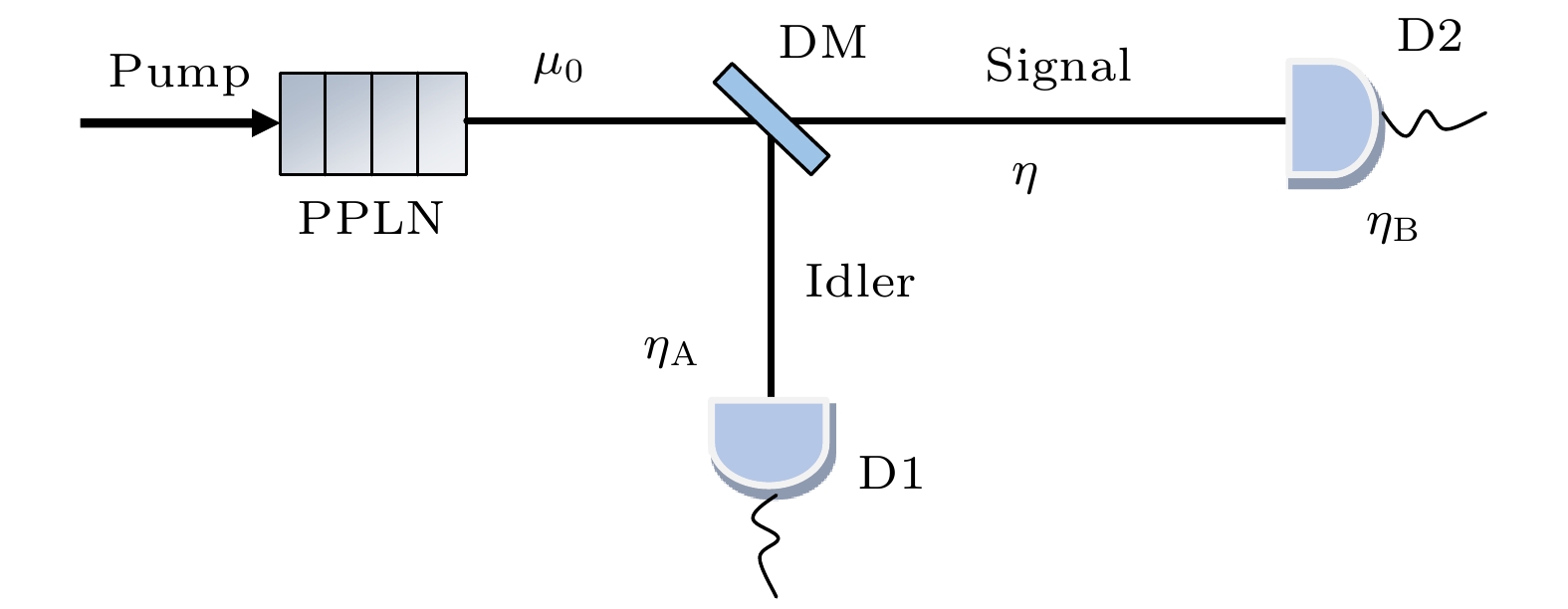
2022, 71 (3): 030301.
doi: 10.7498/aps.71.20211456
Abstract +
In practical quantum key distribution systems, there inevitably exist errors in the quantum state preparation process due to imperfections in realistic equipment and devices. Those errors would lead to some security loopholes in the quantum key distribution systems. According to the work of Tamaki et al. (Phys. Rev. A 90 052314 ), here in this work we propose a state preparation error tolerant quantum key distribution protocol through using heralded single-photon sources. In this protocol, we characterize the size of the error in the preparation state of Alice and bring it into the security analysis, thereby avoiding possible security loopholes and improving the security of the system. Moreover, we take the three-intensity decoy-state method for example to introduce the method of constructing the model and estimating the parameters, and carry out corresponding numerical simulations. We make a comparison between the loss tolerant protocol with weak coherent source (WCS) and our present protocol using heralded single-photon source (HSPS). Simulation results show that under the same state preparation error, the key generation rate of the protocol based on WCS is higher than that of protocol based on HSPS at short transmission distances (e.g. less than 150 km). The main reason is that the detection efficiency of the local detector used in the latter scheme is low. However, in the case of long transmission distances (e.g. greater than 200 km), the key generation rate of scheme with WCS drops deeply, while the decline of the key generation rate of the present scheme is much flatter. As a result, the former can no longer generate keys after 211 km, while the latter can transmit a maximum distance of 228 km. Moreover, we also make a comparison between the present scheme and the GLLP protocol with HSPS. The simulation results show that the GLLP protocol with HSPS is very sensitive to the state preparation error and its key generation rate will rapidly decrease with the increase of the state preparation error. On the contrary, our present protocol shows almost no performance degradation under practical state preparation errors. It thus verify the robustness against the state preparation errors of our present work. In addition, in principle, the method can also be combined with the measurement-device-independent quantum key distribution protocol and the twin-field quantum key distribution protocol to further increase the secure communication transmission distance that the present system can reach. Therefore, this work may provide an important reference value for the practical application of long-distance quantum secure communication in the near future.
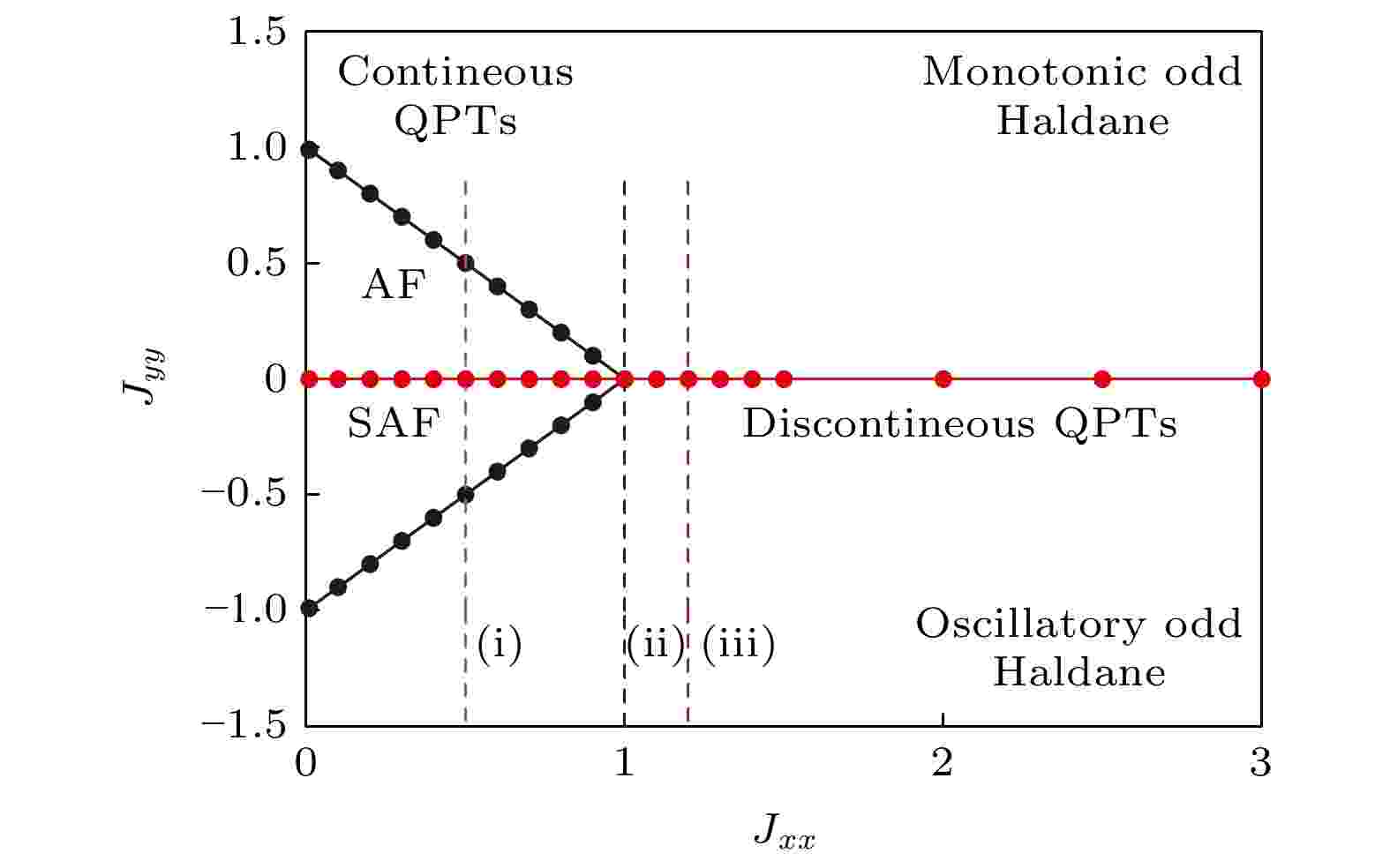
2022, 71 (3): 030302.
doi: 10.7498/aps.71.20211433
Abstract +
Quantum phases (QPs) and quantum phase transitions (QPTs) are very important parts of the strongly correlated quantum many-body systems in condensed matter. To study the QPs and QPTs, the systems should include rich quantum phase diagram. In this sense, the corresponding quantum spin models should have strong quantum fluctuation, strong geometric frustration, complicated spin-spin exchange or orbital degrees of freedom, which induces a variety of spontaneous symmetry breaking (SSB) or hidden spontaneous symmetry breaking. The QPs induced by the SSB can be characterized by local order parameters, a concept that originates from Landau-Ginzburg-Wilson paradigm (LGW). However, there is also a novel class of topological QPs beyond LGW, which has aroused one’s great interest since the Haldane phase was found. Such QPs can be characterized only by topological long-range nonlocal string correlation order parameters instead of local order parameters. In this paper, we investigate a spin-1/2 quantum compass chain model (QCC) with orbital degrees of freedom in x, y and z components. The prototype of QCC is the quantum compass model including novel topological QPs beyond LGW, and consequently one can also anticipate the existence of novel topological QPs in QCC. However, very little attention has been paid to the QPs and QPTs for QCC, which deserves to be further investigated. By using the infinite time evolving block decimation in the presentation of matrix product states, we study the QPs and QPTs of QCC. To characterize QPs and QPTs of QCC, the ground state energy, local order parameter, topological long-range nonlocal string correlation order parameters, critical exponent, correlation length and central charge are calculated. The results show the phase diagram of QCC including local antiferromagnetic phase, local stripe antiferromagnetic phase, oscillatory odd Haldane phase and monotonic odd Haldane phase. The QPTs from oscillatory odd Haldane phase to local stripe antiferromagnetic phase and from local antiferromagnetic phase to monotonic odd Haldane phase are continuous; on the contrary, QPTs from local stripe antiferromagnetic phase to local antiferromagnetic phase and from oscillatory odd Haldane phase to monotonic odd Haldane phase are discontinuous. The crossing point where the line of continuous QPTs meets with the line of discontinuous QPTs is the multiple critical point. The critical exponents β of local antiferromagnetic order parameter, local stripe antiferromagnetic order parameter, topological long-range nonlocal oscillatory odd string correlation order parameter, and topological long-range nonlocal monotonic odd string correlation order parameter are all equal to 1/8. Moreover, $\beta =1/8$ and the central charges $c = 1/2$ at the critical points show that the QPTs from local phases to nonlocal phases belong to the Ising-type universality class.

2022, 71 (3): 030501.
doi: 10.7498/aps.71.20211549
Abstract +
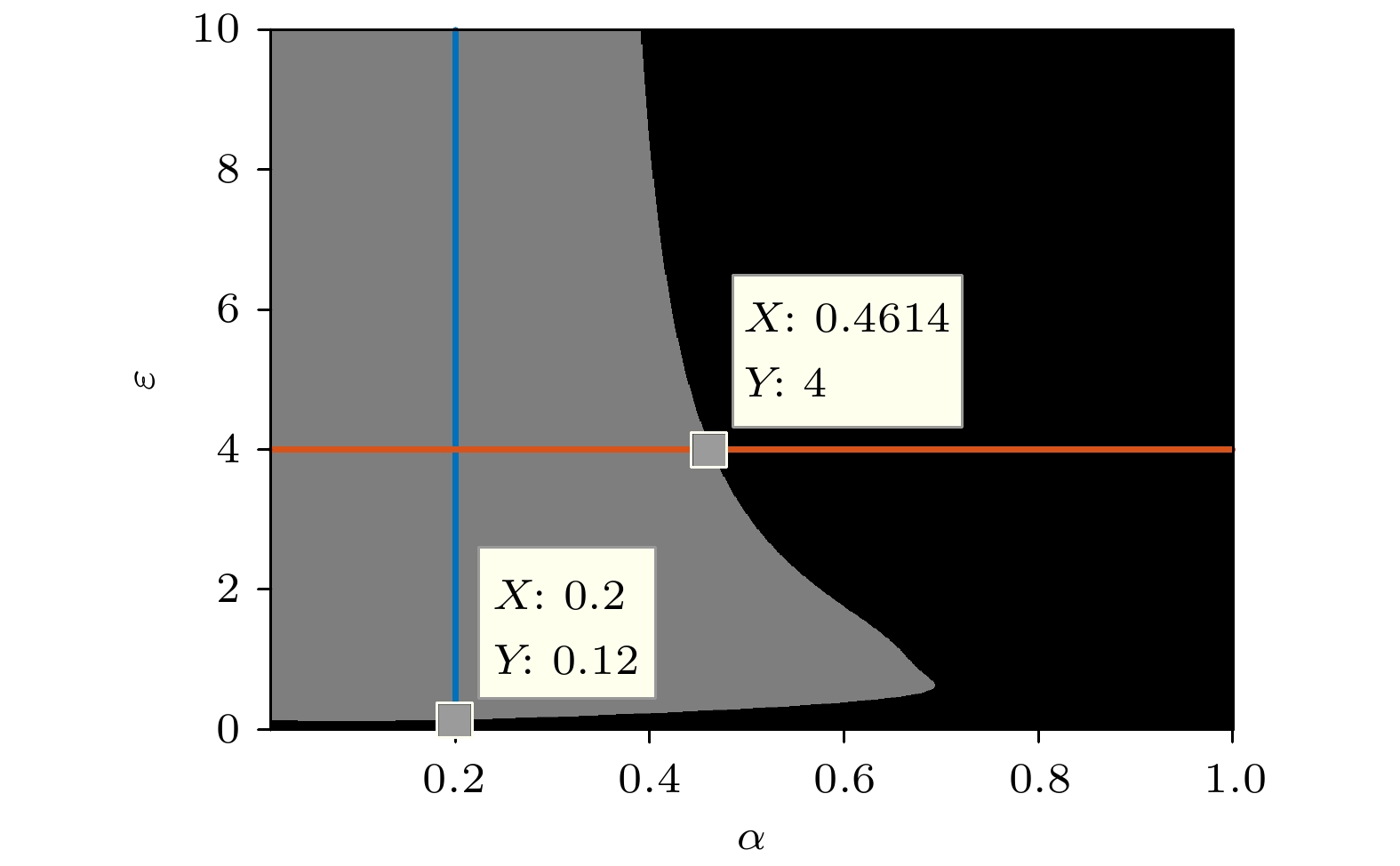
2022, 71 (3): 030502.
doi: 10.7498/aps.71.20211272
Abstract +
In order to describe the motion behavior of coupled particles with mass fluctuations in a viscous medium, we propose a corresponding model, namely a fractional-order coupled system excited by trichotomous noise. By using the Shapiro-Loginov formula and the Laplace transform, we find the statistical synchronization of the system, then obtain analytical expression of the system output amplitude gain. On this basis, this paper focuses on the key points, which are the coupled system, the fractional order system and the trichotomous noise, analyzes the influences of coupling coefficient, system order and noise steady-state probability on the generalized stochastic resonance phenomenon of system’s output amplitude gain, and gives some reasonable explanations. Specifically, first, as the coupling coefficient increases, the generalized stochastic resonance phenomenon of the output amplitude gain of the system first increases and then weakens until it converges. This phenomenon shows that the appropriate coupling strength can promote the generation of system resonance, thereby reflecting the importance of studying coupled systems. Second, with the order of the system increases, the generalized stochastic resonance phenomenon of the system’s output amplitude gain weakens gradually. When the system order value is 1, that is, when the system degenerates into an integer order system, the peak value of its output amplitude gain is smallest. This phenomenon shows that the fractional order system can obtain a larger output amplitude gain than the traditional integer order system. Third, the effect of the steady-state probability of noise on the output amplitude gain of the system changes with other related parameters. Under certain parameter conditions, trichotomous noise can not only make the output amplitude of the system larger than that of the system excited by dichotomous noise, but also change the resonance type of the system. Finally, the correctness of the above results is verified by numerical simulation.

2022, 71 (3): 030503.
doi: 10.7498/aps.71.20211276
Abstract +
Molecular dynamics method is used to simulate the influence of the mesopore size and structure on the heat transport characteristics of the mixed nitrate. The Material Studio software is used to establish the mixed nitrate models of different scales and two structures, and the NaNO3-KNO3 models of different proportions that reach the eutectic state. By calculating the models and sorting out the calculation results, the phase transition of mixed nitrates on a nanometer scale is calculated and the micro-mechanism of heat transport characteristics is analyzed. The results show that the phase transition temperature of the solar salt first increases and then decreases with the increase of the nanopore size, and finally is consistent with the melting point on a macro scale. The proportion of cations has a great influence on the phase transition temperature of mixed nitrate, and the nanowire structures also change the phase transition temperature of nitrate. The bulk thermal expansion coefficient of nitrate decreases with the increase of mesoporous size, increases with the increase of NaNO3 content, and changes with the mesoporous structure. The enhancement of the interaction between ions will increase the thermal conductivity, but it will not have much effect on the specific heat capacity at a constant pressure.

EDITOR'S SUGGESTION
2022, 71 (3): 030701.
doi: 10.7498/aps.71.20211437
Abstract +
ATOMIC AND MOLECULAR PHYSICS

2022, 71 (3): 033101.
doi: 10.7498/aps.71.20211864
Abstract +
Nanowire-based electrodes have attracted much attention due to their high surface energy, short distance for lithium insertion, and the ability to accommodate the enormous strain. However, the buckling behavior may occur during lithiation for such wire-like electrodes, which would lead the battery performance to deteriorate. Therefore, it is vital to quantitatively understand the mechanism about the bucking behavior of the nanowire-based electrodes. Although the buckling behavior of wire-like electrode has been extensively studied in the past few decades, the influence of surface effect on it has not yet been thoroughly explored. For this purpose, a theoretical model of surface effects on buckling of nanowire electrode is presented by taking into account the lithium diffusion, stress, and concentration-dependent elastic properties. Based on the established model, the effects of the residual surface tension and elastic hardening/softening coefficients on buckling are investigated. The results show that surface effects can improve the mechanical reliability, thus delaying the critical buckling time of nanowire electrode. In addition, it is indicated that the surface effects depend on the radius size and slenderness ratio of the nanowire electrode, specifically, the smaller the radius size and the larger the slenderness ratio, the greater the influence of the surface effect is. Furthermore, compared with elastic hardening, with the participation of surface effects, the larger the elastic softening coefficient, the longer it takes for the nanowire electrode to reach the buckled state, and the better the stability of the electrode is. The novelty of this work is that the proposed models highlight the importance of surface effects on buckling of nanowire electrode. These findings provide a prospective insight into the designing of higher structural reliability of electrode.

EDITOR'S SUGGESTION
2022, 71 (3): 033201.
doi: 10.7498/aps.71.20211663
Abstract +
The precise measurement of the transition wavelength of the fine structure of highly charged ions can not only test basic physical theories including the quantum electrodynamics effect and the electronic correlation effect but also provide key atomic data for astrophysics and fusion plasma physics. Furthermore, highly charged ions are considered as a potential candidate for optical clocks with extremely ultra-high precision. In this work, a new spectral calibration system is built in a high-temperature superconducting electron beam ion trap (SH-HtscEBIT) in the Institute of Modern Physics, Fudan University, and the uncertainty of its spectrum wavelength measurement is evaluated by combining internal and external calibrations. The minimum wavelength uncertainty caused by the new spectral calibration system in the visible light band reaches 0.002 nm. On this basis, the precise measurement of 2s22p 2P1/2-2P3/2 M1 transition wavelength for boron-like Ar13+ is performed at the SH-HtscEBIT by utilizing the new calibration system. The experimentally measured transition wavelength is (441.2567 ± 0.0026) nm. It is currently the experimental result with the highest measurement accuracy of spectroscopy of highly charged ions at the SH-HtscEBIT, which lays the foundation for the precise measurement of the hyperfine splitting and isotope shift of highly charged ions in the future experiments.
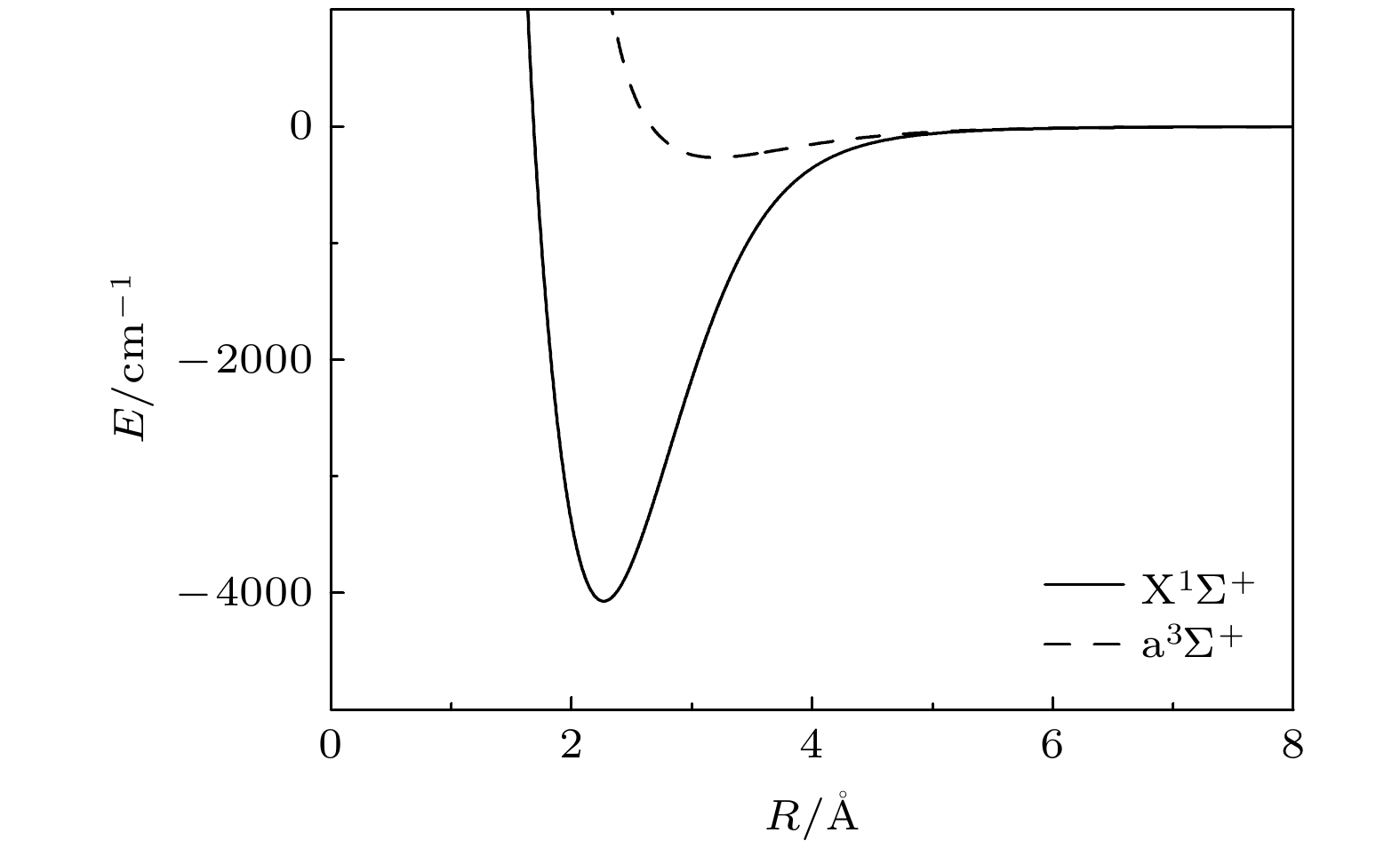
2022, 71 (3): 033401.
doi: 10.7498/aps.71.20211308
Abstract +
The renormalized Numerov algorithm is applied to solving time-independent Schrödinger equation relating to atom-atom collisions at ultralow temperature. The proprieties of Feshbach resonance in 39K-133Cs collisions are investigated as an example. The results show that the renormalized Numerov method can give excellent results for ultracold colliding process. In contrast to improved log derivative method, the renormalized Numerov method displays a certain weakness in computational efficiency under the same condition. However, it is much stable in a wide range of grid step size. Hence a new propagating method is proposed by combining renormalized Numerov and logarithmic derivative method which can save computational time with a better accuracy. This algorithm can be used to solve close-coupling Schrödinger equation at arbitrary temperature for two-body collisions.
ELECTROMAGNETISM, OPTICS, ACOUSTICS, HEAT TRANSFER, CLASSICAL MECHANICS, AND FLUID DYNAMICS
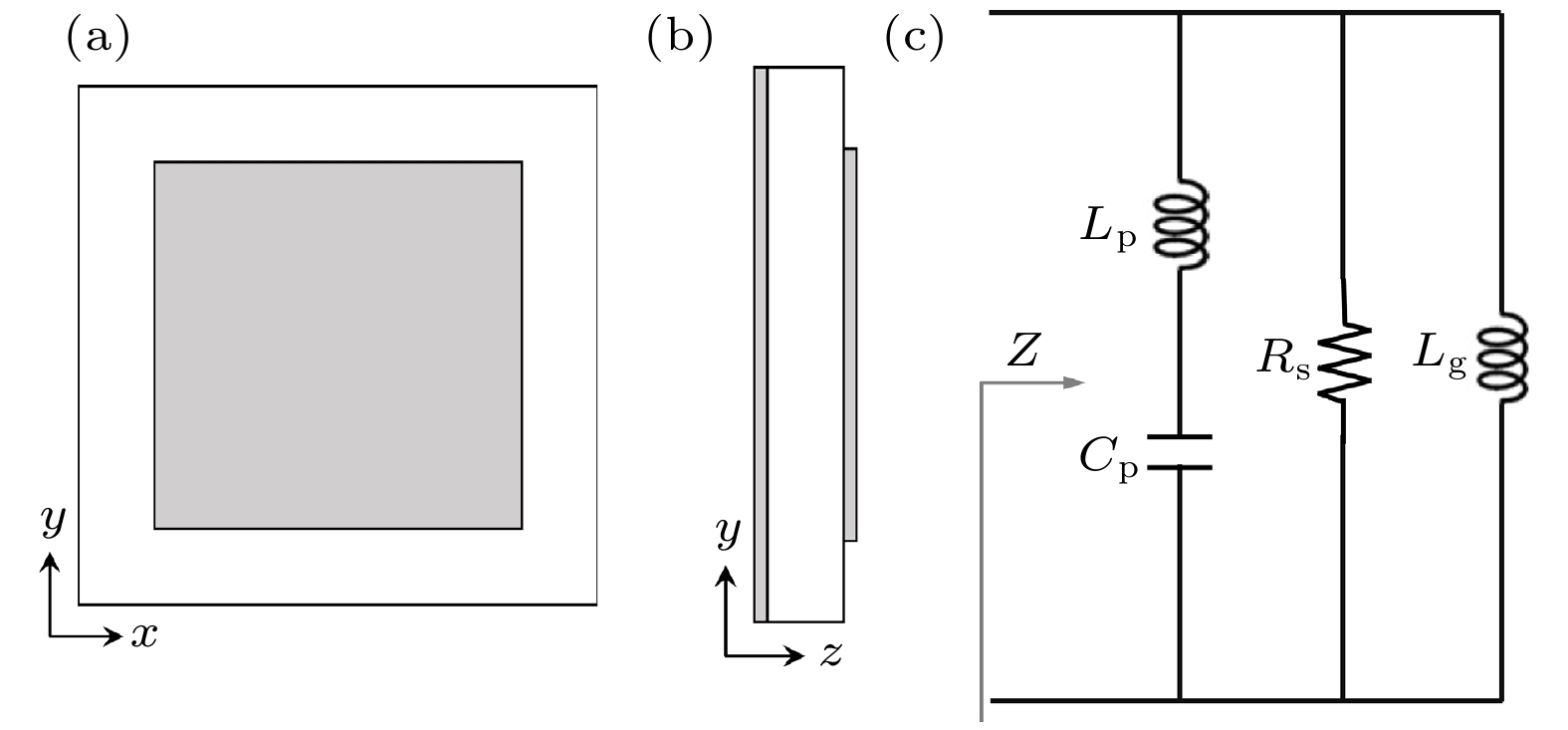
2022, 71 (3): 034101.
doi: 10.7498/aps.71.20211254
Abstract +
Structural radar absorber has important application in stealth field for its ability to effectively absorb incoming radar wave and to bear the load at the same time. Metasurface absorbers can achieve nearly-perfect absorption of radar wave, and have characteristics of light weight and thin structure, but their bandwidth are usually narrow. To solve this problem, a new method of broadening the bandwidth of metasurface absorber is proposed in this work. With varactor and PIN diode integrated in a hybrid manner, the continuous tunning and discrete switching are combined together to broaden the effective absorption bandwidth of the absorber. Using this method, an ultra-wideband tunable metasurface absorber is designed and the absorbing mechanism is analyzed in depth. By changing the bias voltages of PIN diodes and varactors, the absorbing frequency can be continuously tuned within a wide band from 4.57 GHz to 8.51 GHz. Measured results verify the low radar cross section characteristics of the absorber and the effectiveness of the design method. The proposed method is simple and feasible, and can be extended to other broadband structure design.
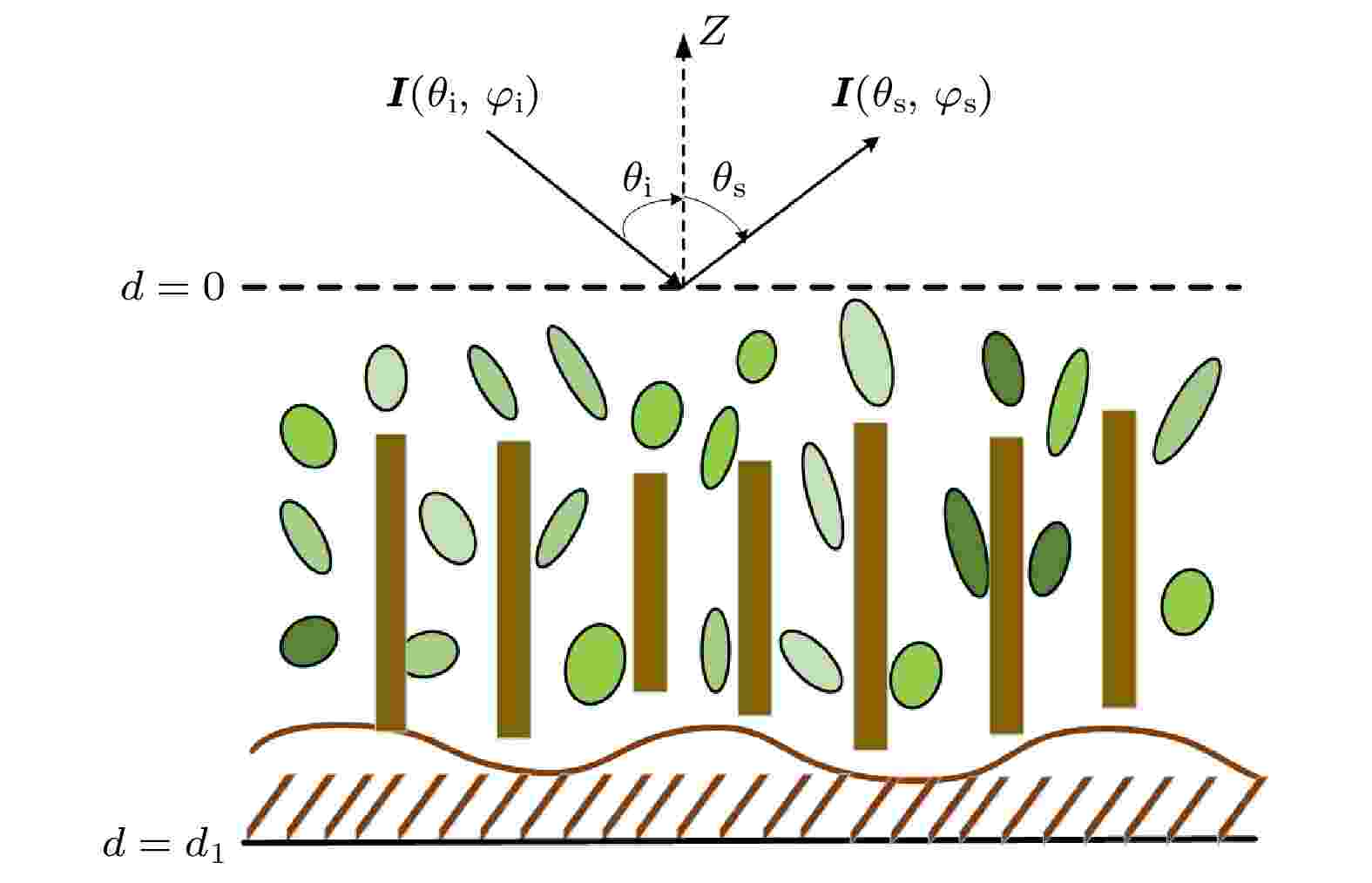
2022, 71 (3): 034201.
doi: 10.7498/aps.71.20211183
Abstract +
In order to investigate the multiple scattering characteristics of energy transmission in a random particle layer on a typical rough surface, a high-order iterative method based on radiative transfer equation is proposed in this work. The particles are placed on the rough surface and the height dimension (Z-axis) is divided into several layers. Then the high-order iterative solution can be obtained by using the first-order iteration solution of radiative transfer equation and the rough surface theory. Moreover, the multiple scattering characteristics between particles, as well as between particles and rough surface can be obtained. Numerical results show that the multiple scattering characteristics can be better explored by the proposed high-order iterative method than by the first-order iteration method. All these interactions can be explained by the energy transfer theory. The proposed high-order iterative method can be used as an efficient tool to explain the multiple scattering characteristics and predict the change of the scattering coefficients.
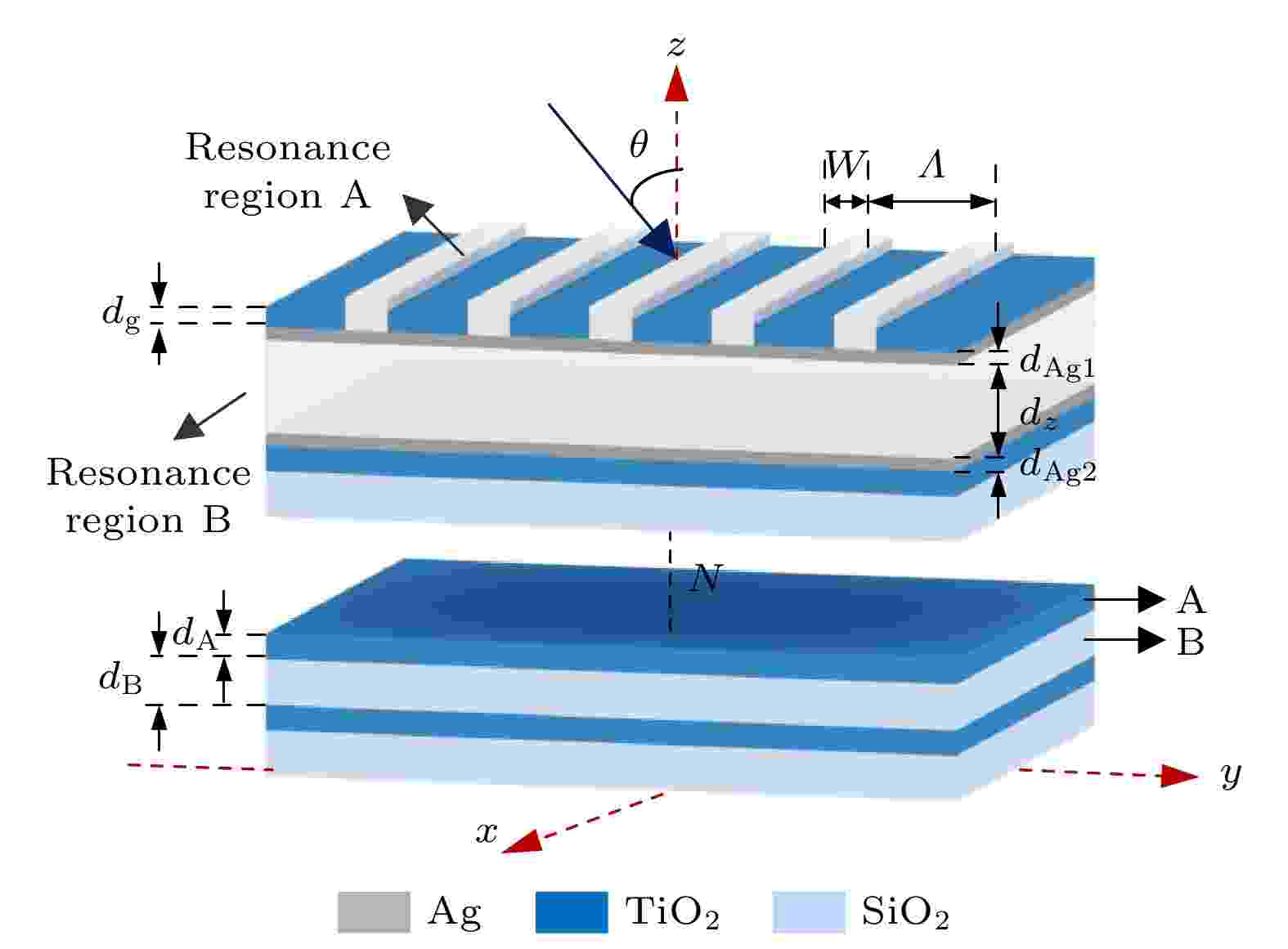
2022, 71 (3): 034202.
doi: 10.7498/aps.71.20211491
Abstract +
Based on the diffraction principle and the mode coupling theory, a composite micro-nano structure of sub-wavelength dielectric grating/metal-dielectric-metal (MDM) waveguide/periodic photonic crystal is proposed. Combined with the angle spectrum of reflection, the transmission characteristics of the surface plasmon polaritons and the generation mechanism of double Fano resonances at different incident angles and fixed wavelength are analyzed. The studies show that the physical mechanism of double Fano resonances is that the surface plasmon resonance generated at the interface of sub-wavelength dielectric grating and upper metal Ag film, and the waveguide mode resonance occurring in the MDM waveguide, provide the independently tunable double discrete states, under the condition of satisfying wave vector matching, which can be respectively coupled in the near field with the continuous state formed by the photonic band gap effect in the photonic crystal, thereby achieving the double Fano resonances. Then the influence of the structural parameters on the double Fano characteristics is analyzed quantitatively, and the evolution law of the double Fano resonances is explored by the change of the reflection spectra of resonance curves. The results show that the tuning between double Fano resonance curves and the resonance angles can be realized by changing the structural parameters. And under optimal conditions, the figure of merit (FOM) values of FR a and FR b in resonance A region can be as high as 460.0 and $ 4.00 \times {10^4} $ , and the FOM values of FR a and FR b in resonance B region can be as high as 269.2 and $ 2.22 \times {10^4} $ . The structure can provide an effective theoretical reference for designing the refractive index sensors based on Fano resonances.
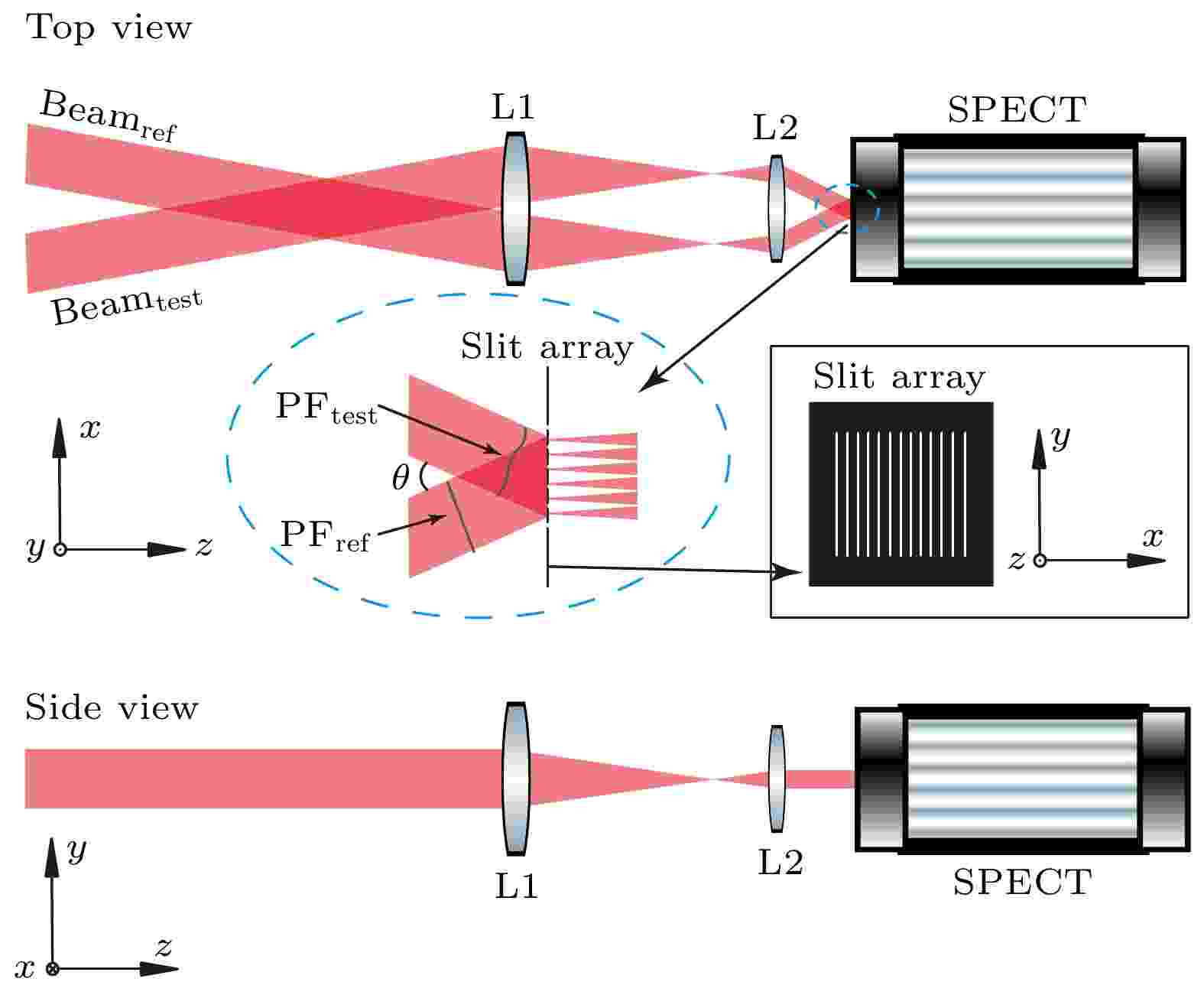
2022, 71 (3): 034203.
doi: 10.7498/aps.71.20211665
Abstract +
The spatiotemporal coupling distortion of large aperture ultra-high peak power laser will degrade the pulsed beam in both near-field and far-field. To accurately predict the light field distribution at the focus and compensate for the spatiotemporal coupling distortion, a single-frame measurement of full three-dimensional spatiotemporal coupling distortion is proposed based on the frequency domain separate spatial-spectral interference. The setup requires only a slit array attached to the front of an Imaging spectroradiometer. The whole procedure of carrier frequency distinguished spectral interference measurement is simulated in this study. The simulation results prove that the presented measuring method is correct and effective. The effectiveness of this method will be further verified experimentally in next step.

2022, 71 (3): 034204.
doi: 10.7498/aps.71.20211295
Abstract +
To examine the single-photon quantum radar cross-section of cylindrical surface and its specific advantages over the classical radar cross-section, a photon wave function in which the distance vectors causing interference are decomposed is introduced in this study. A closed-form expression of the single-photon quantum radar cross-section of cylindrical surface is derived. The influences of the length and curvature radius of cylindrical surfaces with different electrical sizes are analyzed, and the closed-form expressions of the quantum and classical radar cross-sections of cylindrical surface are compared with each other. The analyses of the closed-form expression and simulation results show that the electrical length of the cylindrical surface determines the number of side lobes of the quantum radar cross-section; meanwhile, the curvature radius has a linear relation with the overall strength of the quantum radar cross-section, and the electrical size of the curvature radius determines the envelope of the quantum radar cross-section curve. Compared with the classical radar cross-section, the quantum radar cross-section of a cylindrical surface has the advantage of side-lobe enhancement, which is beneficial for detecting stealth targets.

2022, 71 (3): 034205.
doi: 10.7498/aps.71.20211751
Abstract +
High power fiber laser systems have attracted extensive attention due to compactness, good beam quality, efficient heat dissipation and high conversion efficiency. They are widely used in industrial processing, military, medical treatment and other fields. Over the past two decades, owing to the development of double cladding fiber and high-brightness laser diodes, the output power of fiber lasers has been greatly improved. Unfortunately, nonlinear effects (NLEs), such as stimulated Brillouin scattering (SBS) and stimulated Raman scattering (SRS), restrict the further enhancement of the output power of fiber lasers. Apparently, increasing the core diameter is the most common way to suppress NLEs in the fiber, but this causes another limiting factor, i.e. mode instability (MI), resulting in the deterioration of the beam quality and in the limitation of the power scaling. Therefore, it is important and urgent to suppress the NLEs and MI simultaneously in fiber lasers. The M-type fiber, by designing refractive index profile, breaks through the stringent trade-off between mode area and numerical aperture (NA), so it possesses a larger mode area than the step index fiber, which helps to avoid NLEs and expand the power range. The M-type ytterbium doped double-clad fiber is fabricated by the modified chemical vapor deposition (MCVD) process with solution doping technology (SDT), the core/cladding diameter is 25/400 μm. The NA of high index ring and index dip in the core are 0.054 and 0.025, respectively. To test the performance of the M-type fiber during high-power operation, a 976 nm bidirectional pumped all-fiber amplifier is constructed. As a result, maximum output power of 2285 W is achieved with an optical-to-optical conversion efficiency of 66.5% under bidirectional pumping scheme, and the measured M 2 factor is 1.42, the central wavelength and 3 dB linewidth of output laser are 1080 nm and 3.01 nm, respectively. To the best of our knowledge, this is the highest output power in a continuous-wave fiber laser employing an M-type fiber at present. However, the MI effect is observed at the output power of 2252 W. The future work will focus on optimizing the structure of the M-type fiber to achieve a stabler higher-power and higher-efficiency laser output.

2022, 71 (3): 034206.
doi: 10.7498/aps.71.20211613
Abstract +
The graphene and nanoparticles composites have novel optical and electrical properties. They are widely used in the fields of information sensing, photoelectric conversion and medical diagnosis. Graphene has excellent photoelectric properties and can regulate the random laser properties, but the current composite process of graphene with special structures and metal nanostructures is complicated. Thus, there is still a challenge to effectively reducing the threshold of random laser by using graphene. In this work, the Au/graphene structure is prepared by convenient chemical reduction and adsorption method, and the dye DCJTB is used as the gain medium to form the film by spin coating. The random laser properties of Au nanoparticles and Au/graphene structure are studied, and the mechanism of graphene is analyzed. The results show that the transmission peak of Au/graphene composite is near the photoluminescence peak of gain medium, which promotes the energy level transition of dye molecules. With the addition of graphene into the same gain medium, the scattering frequency of photons in the disordered medium increases, resulting in the enhancement of surface plasmon resonance. The scattering effect and the surface plasmon resonance effect cooperate with each other, showing good random laser threshold, which is reduced from 3.4 μJ/mm2 to 2.8 μJ/mm2. Repeatability and high quality of maser are obtained by repetitively measuring the same sample, showing that the lasing sample has good repeatability and high quality. This study plays a certain role in promoting the application of random laser and realizing the high-performance optoelectronic devices.
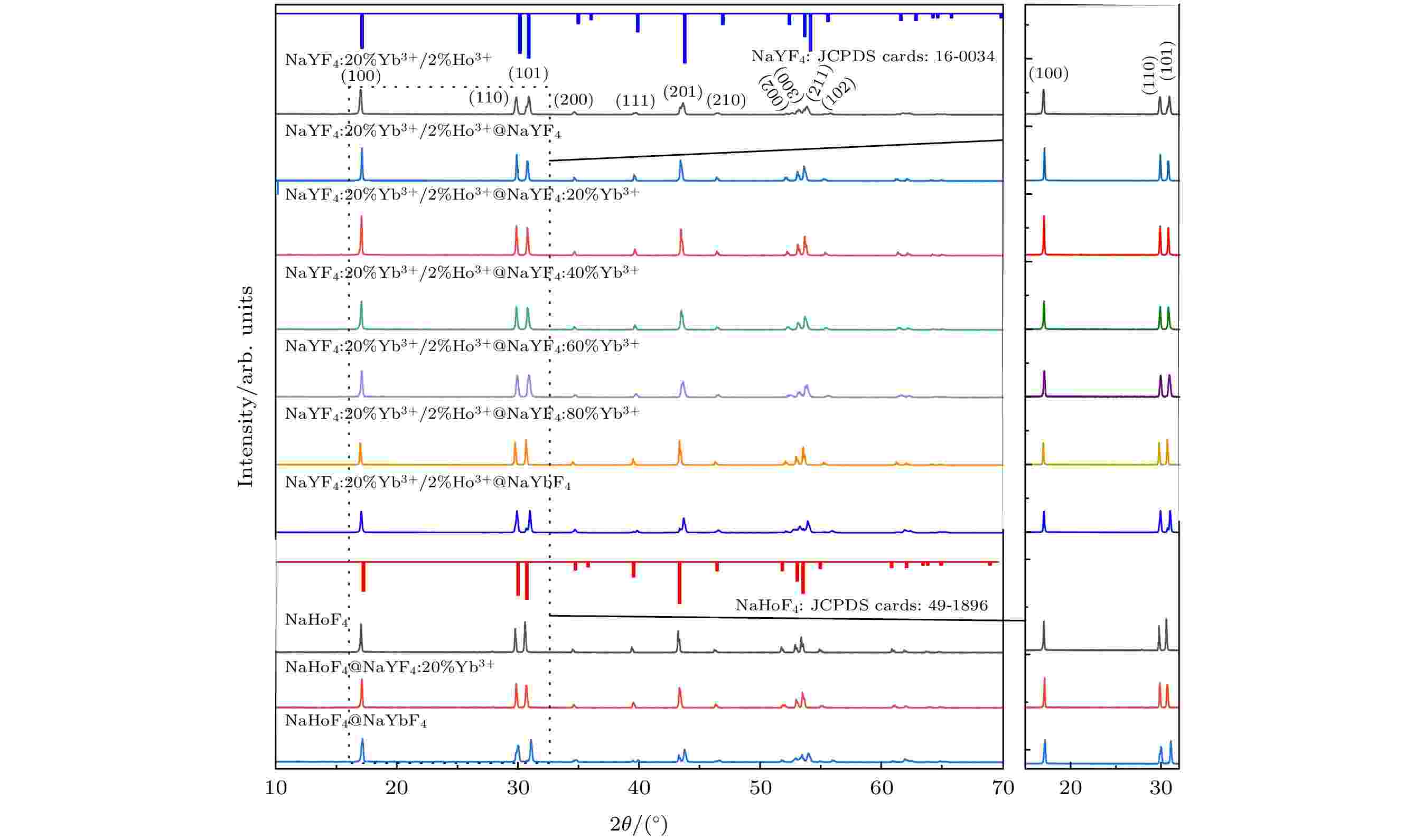
2022, 71 (3): 034207.
doi: 10.7498/aps.71.20211719
Abstract +
Constructing core-shell structures can effectively reduce the surface quenching effect of luminescent materials, which becomes an effective method to enhance upconversion luminescence. In this work, a series of NaLnF4@NaLnF4 (Ln = Y3+, Yb3+, Ho3+) core-shell microcrystals is successfully synthesized based on epitaxial growth technology, thereby enhancing and regulating the upconversion emission of Ho3+ ions. The results of the XRD and SEM indicate that the NaLnF4@NaLnF4 core-shell microcrystal possesses a pure hexagonal-phase crystal structure with a rod-like shape. Meanwhile, it is found that the epitaxial growth direction of the micro-shell is not affected by the crystal characteristics in the core, but determined by the crystal characteristics of the shell. Under 980 nm near-infrared laser excitation, the upconversion luminescence properties of single microrods with different core-shell structures are investigated via a confocal microscope spectroscopy. It is found that in the NaLnF4 micro-crystal, the coated NaYF4 inert shell can also effectively reduce the quenching effect on the surface of the micro-crystal for enhancing upconversion emission. When the Yb3+ ions are introduced into NaYF4 or NaYbF4 active shell that is coated, the Yb3+ ions in the shell can effectively transfer excitation energy to Yb3+ in the core through energy migration, and then establish new energy transfer channels, thereby realizing the Ho3+ ion luminescence enhancement. For NaHoF4@NaYbF4 core-shell microrods, the Yb3+ in the shell can transfer more excitation energy to Ho3+ ions at the adjacent interface for enhancing the overall luminescence intensity, and its higher red-green ratio is mainly due to the cross-relaxation process occurring between the Ho3+ ions at high doping concentration of Ho3+ in the NaHoF4 core. Meanwhile, the luminescence process of the micron core-shell system is further confirmed based on the luminescence characteristics of different structures and the dynamic luminescence process. It can be seen that constructing different micron core-shell structures and introducing sensitizing ions, can not only effectively enhance the luminous intensity of the micron materials, but also adjust the output color. Therefore, this research is an important experimental reference for enhancing the luminous intensity of the micron system and the precise adjustment of luminescence, and can effectively expand the applications of micron crystals in the fields of displays, micron lasers and anti-counterfeiting.
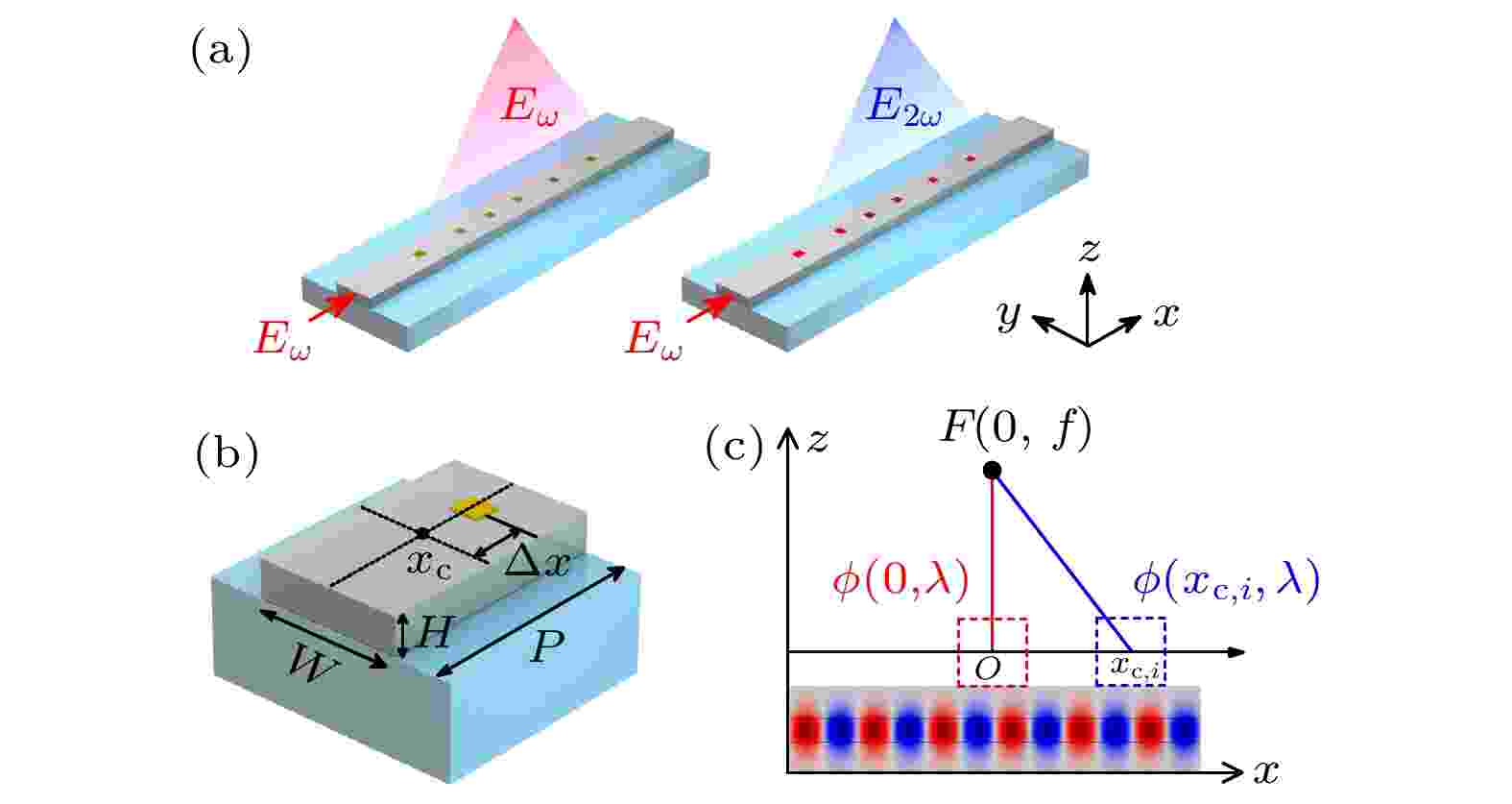
EDITOR'S SUGGESTION
2022, 71 (3): 034208.
doi: 10.7498/aps.71.20211596
Abstract +
It is an important project to use metasurfaces to extend the manipulation of light field by on-chip photonic integrated circuits to the free-space. In this paper, a waveguide mode-driven embedded metasurface is designed by using the propagation phase method. The phase distribution of the metasurface satisfies the focusing of both the fundamental wave and second harmonic wave. On this basis, a phase-change material is chosen to be embedded in waveguide. Combined with its refractive index difference in different phase states, the fundamental wave and second harmonic wave are focused in two phase states, respectively, through the simulation method. When the fundamental wave (or second harmonic wave) achieves high-quality focusing, the components of the second harmonic wave (or fundamental wave) at the focus are suppressed to a large extent, which is more conducive to the subsequent complete filtering. Furthermore, the efficiency at the fundamental wave and second harmonic wave are increased by 2.2 and 3.7 times by embedding another metasurface at the bottom of the waveguide layer which is exactly the same as that at the top but staggers half a period laterally. This study provides a new alternative approach for the linear and nonlinear multifunctional control of guided wave mode-driven metasurfaces.
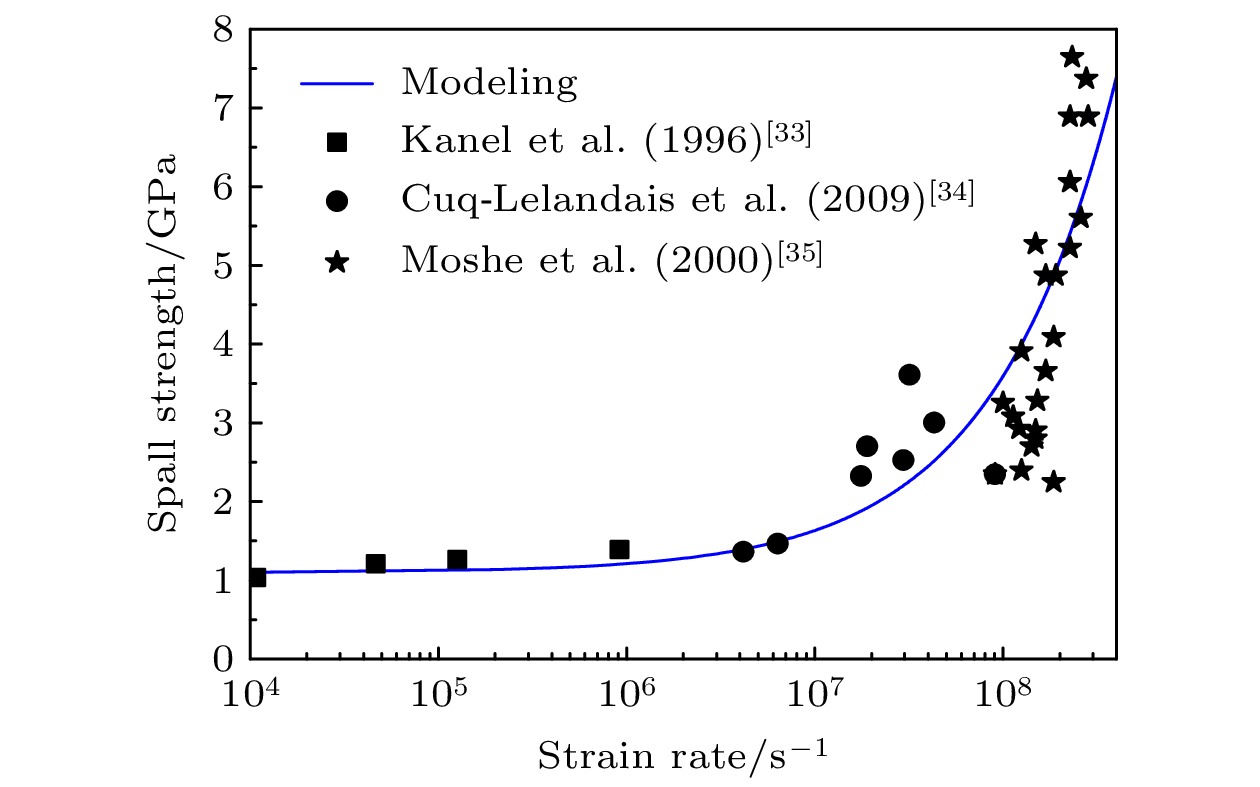
2022, 71 (3): 034601.
doi: 10.7498/aps.71.20210702
Abstract +
When a shockwave, which can be generated by high velocity impact or explosive detonation, reflects from the free surface of a metal, it usually creates tensile stress inside the metal. While the tensile stress is large enough, voids nucleation, growth and coalescence happen inside the metal, causing the metal to spall. As one of the main contents of the spallation damage research, the spallation strength, which is often characterized by features of the free surface velocity history measured in spallation experiments, represents the maximum tensile stress that the material can withstand, and is actually a complex interaction among several competing mechanisms. Optimizing the spallation strengths of metals is important for their applications in the aerospace, automotive, and defense industries, and can be achieved by using the advanced manufacturing strategies, if we can know better the meaning and present analytic model of the spallation strength of metal. A large number of experiments show that the spallation strength of ductile metal is strongly dependent on the tensile strain rate, grain size and temperature of material. Based on the analysis of early spallation evolution and influence of grain size and temperature on the material, a simple analytic model of spallation strength is presented in this paper, which takes into account the effects of strain rate, grain size and temperature in materials. The applicability of this model is verified by comparing the calculated results from the model with the experimental results of spall strength of typical ductile metals such as high purity aluminum, copper, and tantalum.
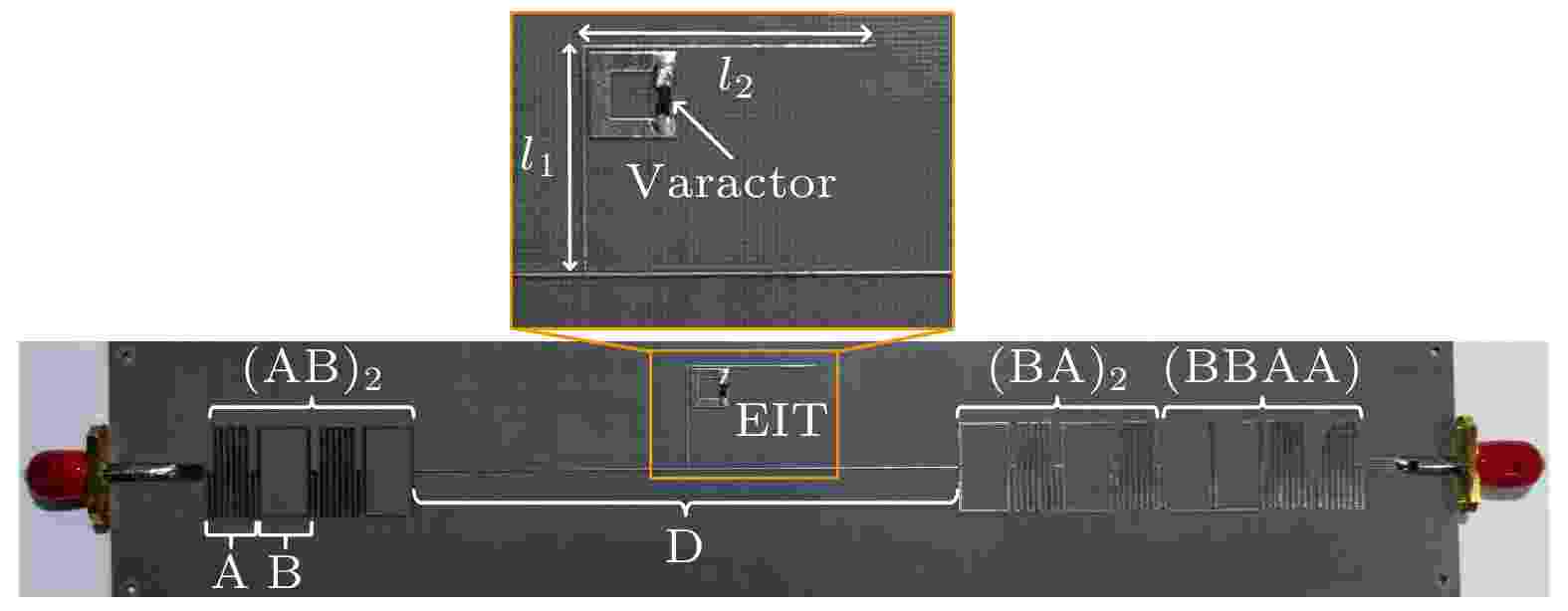
2022, 71 (3): 034701.
doi: 10.7498/aps.71.20211291
Abstract +
A subwavelength electromagnetic diode scheme in a microwave waveguide system is proposed by using an asymmetric photonic crystal (PC) cavity side-coupled with electromagnetically induced transparency like (EIT-like) metamaterials. It is found that the composite PC-EIT configuration can generate tenfold Q-factor enlargement, accompanied with enhanced nonreciprocal electromagnetic localization simultaneously. Further study of the measured one-way response exhibits excellent electromagnetic diode performance including 19.7 dB transmission contrast and 7 dBm operating power at a working frequency of 1.329 GHz. We emphasize that such high-contrast transmission and low-threshold diode actions are not at costs of greatly increasing volume and drastically reducing transmission. Our findings may benefit the design of compact nonreciprocal devices in the integrated optical nanocircuits.
PHYSICS OF GASES, PLASMAS, AND ELECTRIC DISCHARGES

EDITOR'S SUGGESTION
2022, 71 (3): 035201.
doi: 10.7498/aps.71.20211470
Abstract +
The classical trajectory Monte Carlo (CTMC) method is a common method to study the charge-transfer and impact-ionization cross sections for the collisions between ions and atoms, and the heavy particle collision in astrophysics and laboratory plasma environment. Here in this work, we use the 4-CTMC method to study a four-body collision process including two bound electrons, and the Hamiltonian equation of the four-body dynamic system is solved numerically. The single/double electron ionization and capture cross sections are calculated for collisions of high charge state ions (Li3+, Be4+ and O7+) with helium atom in a wide range of projectile energy. The calculation results show that the results from the 4-CTMC method and the experimental measurements are in better agreement in a projectile energy range of 50-200 keV/amu for proton-helium collision system. In addition, for incident ions with high charge state, the results calculated by the 4-CTMC method are in better agreement with the experimental measurements or other theoretical values in a projectile energy range of 100-500 keV/amu. Though the double ionization and capture cross sections calculated by 4-CTMC or 3-CTMC method are higher than the experimental results due to ignoring the electron correlation, the results from the 4-CTMC method are in better agreement with the experimental results.

EDITOR'S SUGGESTION
2022, 71 (3): 035202.
doi: 10.7498/aps.71.20211450
Abstract +
The extreme ultraviolet (EUV) lithography technology, which is required for high-end chip manufacturing, is the first of 35 “neck stuck” key core technologies that China is facing currently. The EUV source with high conversion efficiency is an important part of EUV lithography system. The experiment on dual-pulse irradiated Gd target is carried out to realize the stronger 6.7 nm EUV emission output. Firstly, we compute the contribution of transition arrays of the form 4p-4d and 4d-4f from their open 4d subshell in charge states Gd18+−Gd27+, and transition arrays of the form 4d-4f from their open 4d subshell in charge states Gd14+−Gd17+ on the near 6.7 nm EUV source. Subsequently, the experimental results of the dual pulse laser irradiated Gd target show that the intensity of 6.7 nm peak EUV emission decreases first, then increases and drops again due to the plasma density decreasing gradually when the delay time between the pre-pulse and main-pulse increases from 0−500 ns. The strongest intensity of 6.7 nm peak EUV emission is generated when the delay time is 100 ns. At the same time, the spectrum efficiency is higher when the delay time is 100 ns, which is 33% higher than that of single pulse laser. In addition, the experimental results show that the half width of EUV spectrum produced by dual pulse in the delay between 10−500 ns is narrower than that of signal laser pulse due to the fact that the method of dual pulse can suppress the self-absorption effect. The half width is the narrowest when the delay is 30 ns, which is about 1/3 time of EUV spectrum width generated by a single pulse. At the same time, the narrowing of Gd EUV spectrum improves the spectral utilization efficiency near 6.7 nm wavelength (within 0.6% bandwidth).
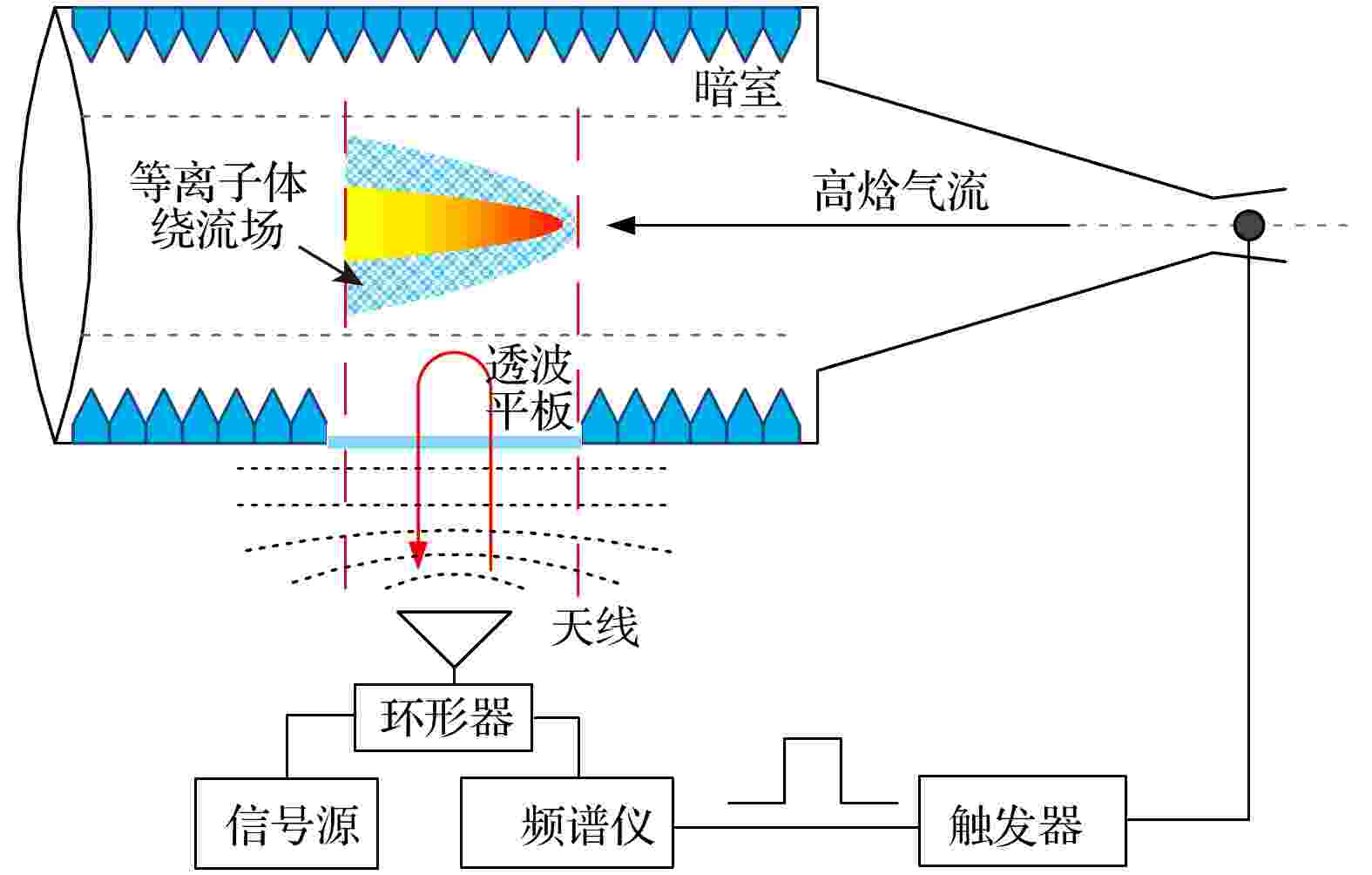
2022, 71 (3): 035203.
doi: 10.7498/aps.71.20211471
Abstract +

EDITOR'S SUGGESTION
2022, 71 (3): 035204.
doi: 10.7498/aps.71.20211172
Abstract +
In laser direct-driven fusion, high power lasers are used to ablate the target shell, compress and heat the fuel with the spherical focusing rocket effect, to approach to the fusion ignition conditions. The shaped nanosecond laser pulses compress and accelerate the DT target symmetrically, and forms a high density plasma hot-spot at stagnation. The hydrodynamic instabilities, especially the Rayleigh-Taylor instability, which happens at the interface of plasmas, may destroy the compressed shells, and thus reduce the temperature and density of the hot-spot. In this paper is analyzed theoretically the hydrodynamic instability growth under the conditions in the 2020 winter experiment of the double-cone ignition scheme proposed by Zhang et al. (2020 Philos. Trans. A Math. Phys. Eng. Sci. 378 20200015 ). Both analytical model and one-dimensional simulations indicate that the fuel shells are compressed with low adiabat under the current quasi-isentropic waveform. The Rayleigh-Taylor instability remains in safe region with a maximum perturbation amplitude reaching 0.25 of the shell thickness at the most peak grown moment. The growth of the hydrodynamic instabilities can be further reduced by increasing the thickness of the shell, through using high foot pre-pulses and improving the uniformity of the target surface and laser irradiation in the future design.
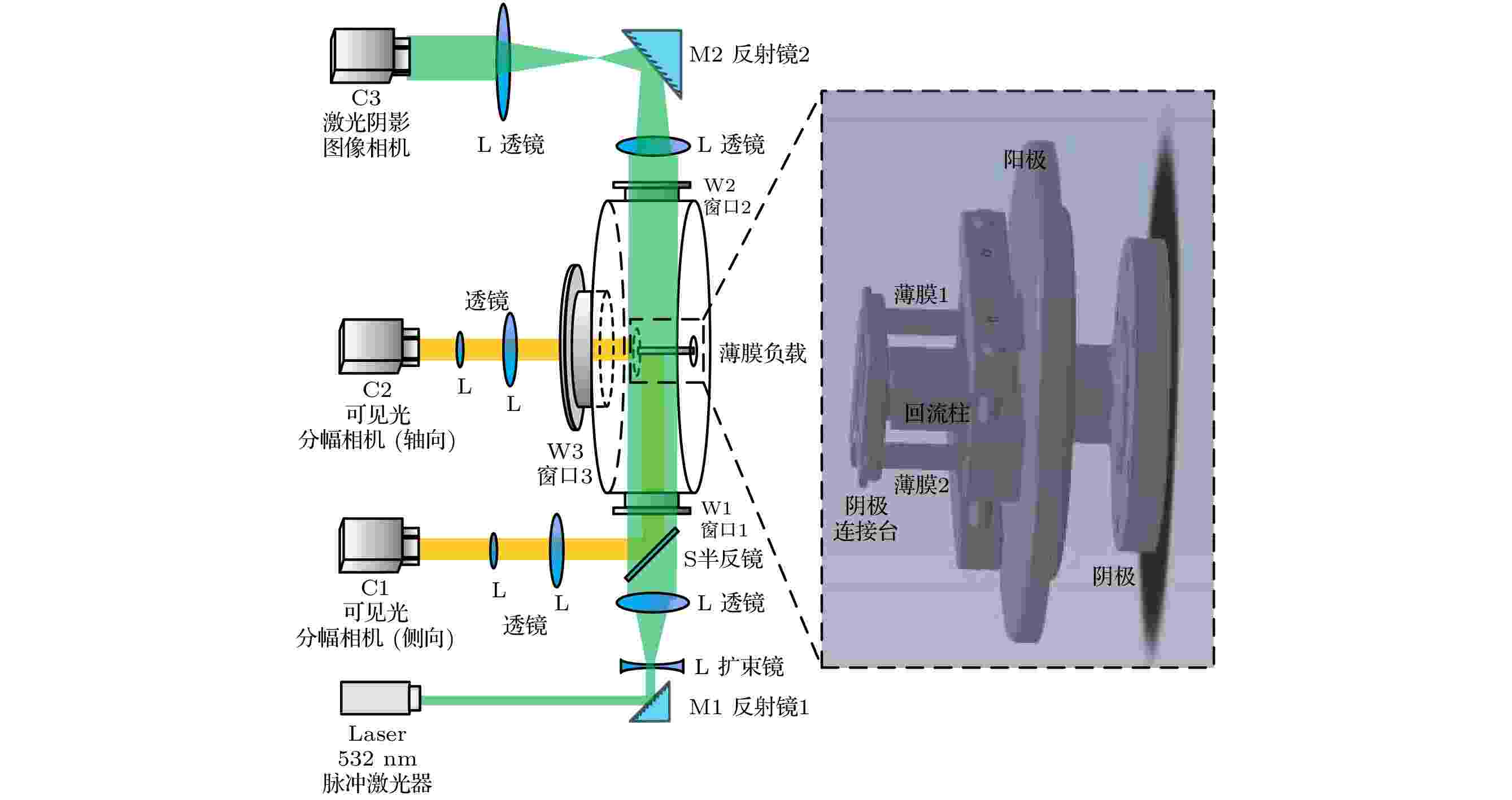
2022, 71 (3): 035205.
doi: 10.7498/aps.71.20211495
Abstract +
In the research of Z-pinch, the initial establishment of current in load, current density distribution mode and current evolution characteristics in different stages are of great significance in studying the development of plasma dynamics, analyzing plasma instability mode, and carrying out the MHD numerical simulation. Thin planar foil is an ideal configuration with continuous two-dimensional structure to study the problem. Based on an ideal model that consists of foil-backpost configuration under the assumption of infinite length in reverse exploding condition, the establishment, distribution and evolution of the current channel, magnetic field distribution characteristics and the force state of foil plasma by the inductive mode are calculated and analyzed theoretically. Relevant experiments are carried out on the QG-1 facility with about 1.4 MA peak current and 100 ns rise time to verify the calculated results. The self-emission graphs of exploding foils are recorded by visible-light frame cameras from side-on view and end-on view. Different load configurations are utilized including symmetric and asymmetric condition both assembled with two 20-μm-thick aluminum foils. The results show that the establishment of the initial current in foil (0–70 ns) accord with the expectation of the inductance model. The inductance feature determines the distribution of the current in this stage, which causes the current to aggregate in foil edges and then the edges will suffer much higher magnetic field and J × B force than the center. This results in the formation of a clamp plasma morphology. The later images (70–120 ns) show that the intense emission region will transfer from the foil edges to the center, which proves a transfer of current channel. So the magnetic field and J × B force in the foil center increase and a peak convex plasma morphology forms then. It shows that the current distribution will be affected by the plasma evolution process. The convergence process of ablated plasma with current finally leads to rapidly switch the current channel (in 60–80 ns).
CONDENSED MATTER: STRUCTURAL, MECHANICAL, AND THERMAL PROPERTIES

2022, 71 (3): 036501.
doi: 10.7498/aps.71.20211434
Abstract +
Silicon carbide (SiC) has been widely used in nuclear technology due to its excellent properties. In the irradiation environment, the energetic incident particles can cause the atoms in the material to deviate from the position of the crystal lattice, thereby producing the vacancies, interstitial atoms, anti-site atoms and other point defects. These defects will change the thermal properties of the material and degrade the service performance of the material. Therefore, in this work the equilibrium molecular dynamics method (Green-Kubo method) is used to study the effect of point defects on the heat transfer properties of cubic SiC (β-SiC or 3C-SiC) with the help of the Tersoff-type potential. The point defects considered include Si interstitial atoms (SiI), Si vacancies (SiV), Si anti-site atoms (SiC), C interstitial atoms (CI), C vacancies (CV) and C anti-site atoms (CSi). It is found that the thermal conductivity (λ) decreases with the increase of the point defect concentration (c). The excessive thermal resistance (ΔR = Rdefect – Rperfect, R = 1/λ, Rdefect is the thermal resistance of the defective material, and Rperfect is the thermal resistivity of the material without defects) has a linear relation with the concentration of point defects in the considered range (0.2%–1.6%), and its slope is the thermal resistivity coefficient. It can be found that the thermal resistivity coefficient of vacancy and interstitial atoms are higher than that of anti-site atoms; the thermal resistivity coefficient of point defects at high temperature is higher than at low temperature; the thermal resistivity coefficient of Si vacancies and Si interstitial atoms are higher than that of C vacancies and C interstitial atoms. These results are helpful in predicting the thermal conductivity of silicon carbide under irradiation and controlling the thermal conductivity of silicon carbide.

2022, 71 (3): 036801.
doi: 10.7498/aps.71.20211631
Abstract +
Biphenylene monolayer is composed of four-, six- and eight-membered carbon rings and has a monatomic layer structure similar to graphene. It was synthesized in experiment recently and reported in Science in May 2021, which has attracted considerable attention in the research field of two-dimensional materials. By the density functional method of the first principle, we study the adsorption configuration of Fe atoms on biphenylene monolayer and analyze its electronic structure. The calculation of structural optimization, adsorption energy and molecular dynamics show that the biphenylene monolayer is a good matrix of Fe atoms. For Fe atoms, the hollow site in the four-membered ring of the biphenylene monolayer is the most stable adsorption site, and the adsorption energy can reach 1.56 eV. The calculation of charge transfer and density of states show that a stable bond can be formed between biphenylene monolayer and Fe atoms, and 0.73 electron is transferred from Fe atom to the neighbored carbon atom. After Fe atom being absorbed, biphenylene monolayer is magnetic, and the magnetic moment of Fe atom is about 1.81 ${\mu}_{\mathrm{B}}$ and points out of the plane. Compared with graphene, biphenylene monolayer adsorbs Fe atoms more stably, which provides a new platform for studying the electromagnetic, transport and catalytic properties of two-dimensional materials with adatoms.
CONDENSED MATTER: ELECTRONIC STRUCTURE, ELECTRICAL, MAGNETIC, AND OPTICAL PROPERTIES

2022, 71 (3): 037101.
doi: 10.7498/aps.71.20211516
Abstract +
On the basis of first-principles calculations, the structure, magnetism and ferroelectricity of VOBr2 monolayer are studied systematically in the present work. The calculation results indicate that a spontaneous ferroelectric distortion takes place at low temperature, causing the structure of VOBr2 to transform from a centrosymmetric paraelectric phase to a ferroelectric one. In contrast with its sister compound VOI2, the dimerization of V is unstable in VOBr2 and may quench the local magnetic moment on V ions. Additionally, the easy magnetization axis of VOBr2 monolayer is in-plane along the a-axis, and the magnetic coupling between adjacent local moments is antiferromagnetic both along the a-axis and along the b-axis. Moreover, the ferroelectric displacement of V ions occurs in the a-axis, along the V—O—V chains direction, resulting in a polarization of about 40 μC/cm2. Comparing with the ferro-to-paraelectric reversal pathway, the energy barrier can be effectively reduced for ferroelectric switching on partial or individual V—O—V chains. It is reasonable to believe that the dipole moment flipping on specific chain can be achieved through a moderate external field, thereby providing new direction for designing the low-energy-consumption and high-density ferroelectric memory device.
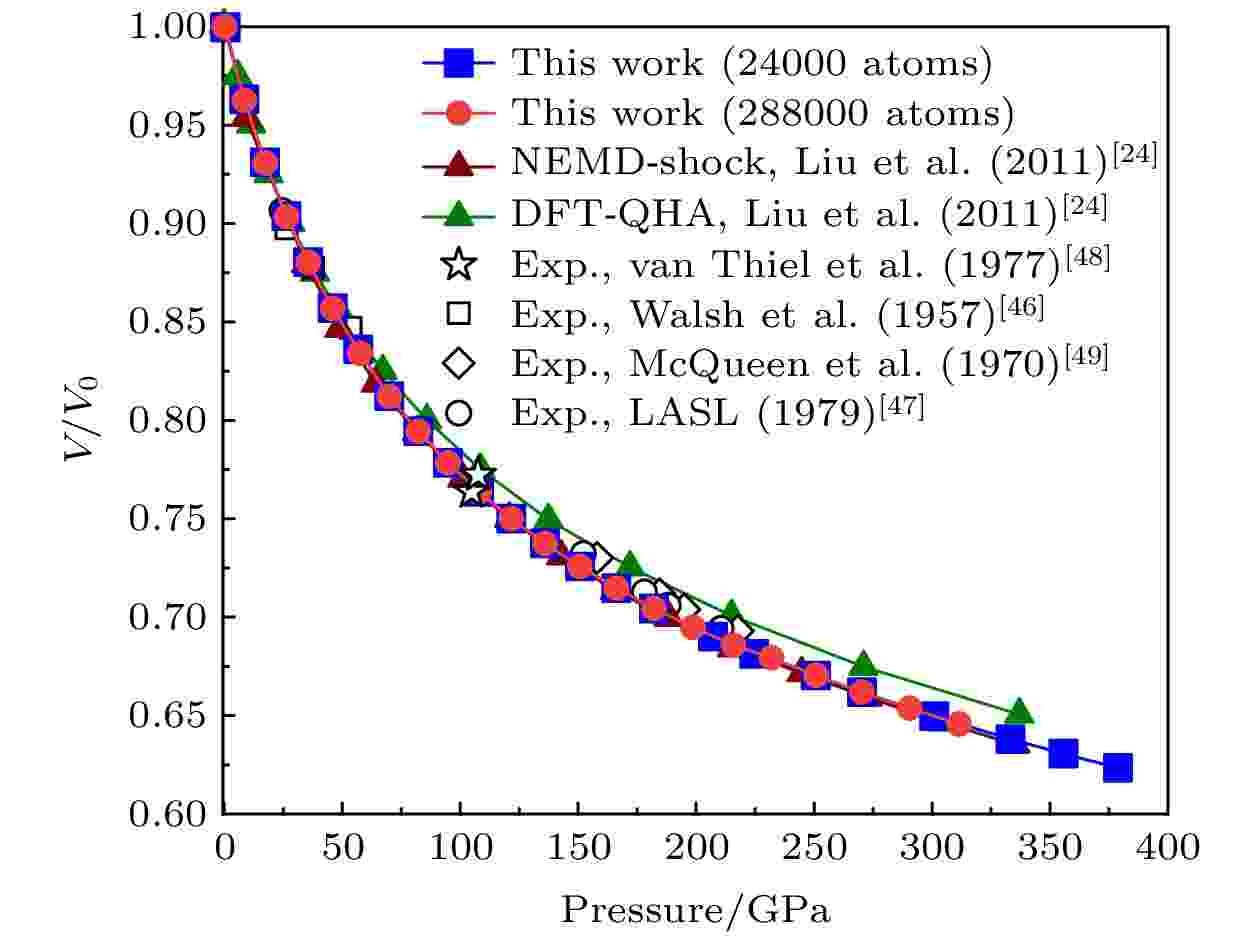
2022, 71 (3): 037102.
doi: 10.7498/aps.71.20211511
Abstract +
For palladium (Pd) as a typical high-pressure standard material, studying its structural changes and thermodynamic properties under extreme conditions is widely demanded and challenging. Particularly, the solid-solid phase transition process of Pd under shock loading is understood still scarcely. In this paper, using the classical molecular dynamics simulations with embedded atom method (EAM) based on the interatomic potential, we investigate the phase transition of single crystal Pd from atomic scale under shock loading. A series of structural features is observed in a pressure range of 0–375 GPa, revealing that the structure feature transforms from the initial face-centered cubic (FCC) structure to the stacking faults body-centered cubic (BCC) structure with hexagonal close-packed (HCP) structure, and finally complete melting. Under shock loading of $ \left\langle {100} \right\rangle $ oriented bulk Pd, we find the transformation to BCC structure can take place almost at 70.0 GPa, which is much lower than the previous static calculation result. In addition, we find that the phase transition depends on the direction initially impacting crystal. Under impacting along the $ \left\langle {110} \right\rangle $ direction and the $ \left\langle {111} \right\rangle $ direction, the FCC-BCC phase transition pressures increase to 135.8 GPa and 165.4 GPa, respectively. Also, the introduction of defects will increase the phase transition pressure of FCC-BCC by 20–30 GPa in comparison with perfect crystals, which is verified by the distribution of the potential energy. An interesting phenomenon that FCC-BCC transition pressure of Pd decreases under shock loading is found in this work, which provides a new theoretical insight into the application of high pressure experiments in the future.

2022, 71 (3): 037201.
doi: 10.7498/aps.71.20211443
Abstract +
Real-time monitoring of high intensity focused ultrasound (HIFU) focal region is a key problem in clinical treatment of focused ultrasound. At present, the change of strong echo in B-ultrasound image is often used in clinical practice to monitor tissue damage in the focal area. However, the strong echo in B-ultrasound image is mostly related to cavitation and boiling bubbles in the focal area, which cannot monitor the treatment status accurately or in real time. In the HIFU treatment, the focal area tissue will be accompanied by changes in temperature, cavitation, boiling, and tissue characteristics. The acoustic load on the surface of the transducer is also constantly changing. To solve this problem, a real-time detection platform of transducer voltage and current is built in this work, which can sense the change of focal area tissue state by measuring the electrical parameters of the transducer. The experimental results show that the stability of the phase difference of the transducer driving signal will be different (the fluctuation amplitude will be different) when different media are placed on the surface of the transducer to change the acoustic load on the surface of the transducer. The fluctuation amplitude of the phase difference of the driving signal will be larger than that in the water when the iron plate is placed in the focal plane. However, the phase fluctuation amplitude will be much smaller than that in the water where the beef liver is placed. This shows that different acoustic loads can cause the electrical parameters of the transducer to change. The isolated bovine liver tissue is used as the HIFU irradiation object, and the results of the phase difference change are compared with the results of the isolated bovine liver tissue damage. The experimental results show that the phase of the transducer voltage and current will change from relatively stable to large fluctuations during the HIFU irradiation. At this time, obvious damage can be seen in the focal region when the irradiation is stopped, and the grayscale of B-ultrasound image has no significant change. In addition, when the cavitation occurs in the focal region, the fluctuation amplitude and range will turn larger. The damage area of the lower focal area under the monitoring method is smaller than that under B-ultrasonic monitoring, and the over input of radiation dose can be avoided. This method can provide a new research scheme and means for HIFU focal area tissue damage monitoring.

2022, 71 (3): 037202.
doi: 10.7498/aps.71.20211265
Abstract +
In order to improve the radiation-resistance ability of the InP based high electron mobility transistor (InP HEMT) by optimizing the epitaxial structure design, a series of InP HEMT epitaxial structure materials with different structure parameters is grown by gas source molecular beam epitaxy. These samples are irradiated at room temperature by a 1.5-MeV electron beam at the same irradiation fluence of 2 × 1015 cm–2. The electrical properties of the two-dimensional electron gas (2DEG) for InP HEMT epitaxial materials before and after irradiation are measured by Hall measurements to obtain the changes of the normalized 2DEG density and electron mobility along with the epitaxial structure parameters. The relation between 2DEG radiation damage and epitaxial structure parameters (such as Si-δ-doping density, spacer thickness, channel thickness and channel In content) of InP HEMT epitaxial structure materials is analyzed. The results show that the 2DEG of the InP HEMT epitaxial structure material with higher Si-δ-doping density, thinner spacer thickness, thicker channel thickness and lower channel In content has lower radiation damage, which possesses the stronger radiation-resistance ability.

EDITOR'S SUGGESTION
2022, 71 (3): 037301.
doi: 10.7498/aps.71.20211536
Abstract +
Gallium oxide is a new generation of wide band gap materials, and its device has excellent performance. The barrier control of Ga2O3 Schottky diode by n+ high concentration epitaxial thin layer is studied. The results show that the performance of Schottky diode has greatly improved after epitaxy of n-type gallium oxide. The vertical current density is 496.88A·cm–2, the reverse breakdown voltage is 182.30 V, and the calculated Ron is 0.27 mΩ·cm2 when the epitaxial concentration is 2.6 × 1018 cm–3 and the thickness is 5 nm. Further studies indicate that the current density increases with the increase of the layer thickness and the concentration. Theoretical analysis shows that the barrier is controlled by mirror force, series resistance and tunnel effect. Of them, the tunnel effect has the greatest influence, which makes the barrier height decrease with the layer concentration as $\sqrt {{n}}$ and the thickness as $\sqrt {{a}}$ . As a result, the hot emission current and the tunnel current increase simultaneously, which improves the performance of Ga2O3 Schottky diode.
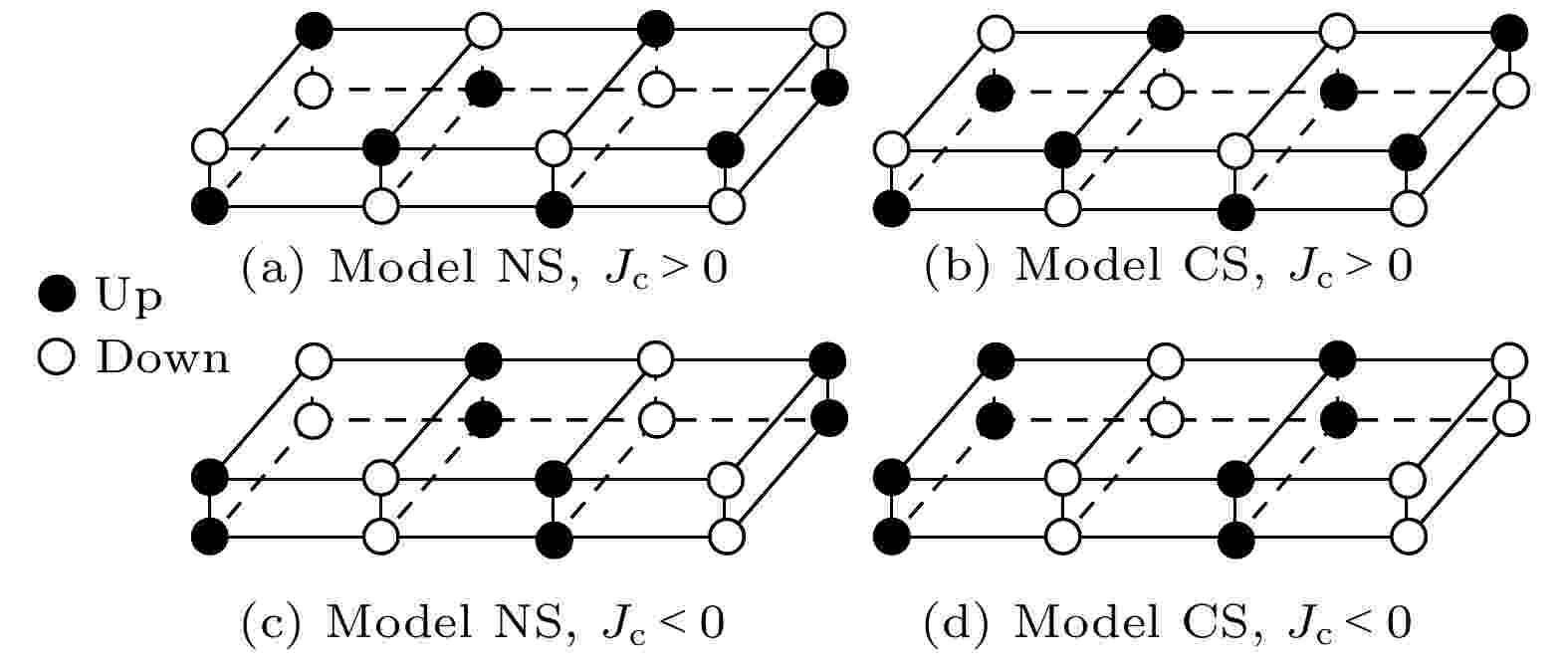
2022, 71 (3): 037501.
doi: 10.7498/aps.71.20211584
Abstract +
In this paper, we investigate the ground state phase transition of the spin-1/2 frustrated model on a stacked square lattice by the linear spin wave method. The effects of the anisotropy and the interplay of neighboring couplings on phase diagram and phase transformation between the Nèel state and collinear state are explored. Our results show that both the Nèel state and collinear state can exist due to the interplay of interlayer coupling $ {J_{\text{c}}} \geqslant 0.21 $ or $ {J_{\text{c}}} \leqslant - 0.175 $ for an isotropic system. For an anisotropic system, both the Nèel state and collinear state may also exist. In this case, for the weak anisotropy, the Nèel state is more stable. For the strong anisotropy, the system will undergo a first-order phase transition from the Nèel state to the collinear state.

2022, 71 (3): 037801.
doi: 10.7498/aps.71.20211381
Abstract +
The plasmonic anisotropic nanostructure possesses the enhanced surface electric field and unique optical properties in near-infrared spectrum, thus it has potential applications in nano-optoelectronics and medical sensing. To obtain the best property, the excitation polarization normally needs to match the orientation of the structure. The strong polarization dependence, however, greatly limits the excitation efficiency. In this work, a patchy structure is introduced to release the dependence of polarization. In the proposed method here in this work, the lost properties due to unmatched polarizations are compensated for by the plasmonic resonance coupling between the patch and capped structure in the heterozygous dimer. By overlapping the two modes at the same wavelength, the absorption keeps rather stable undisturbed status during the variation of incident polarization. This work focuses on the theoretical exploration of the feasibility. Electromagnetic field in the interaction between light and heterozygous dimer is essential before extinction coefficient is calculated. The field of the model is obtained by solving Maxwell equations through using the finite element method. The numerical calculation presents a good understanding of the mechanism of the plasmonic interactions in the dimer, based on which the nanostructure with optimized configuration parameters can achieve the stable and high absorption in the near infrared wavelength.
INTERDISCIPLINARY PHYSICS AND RELATED AREAS OF SCIENCE AND TECHNOLOGY
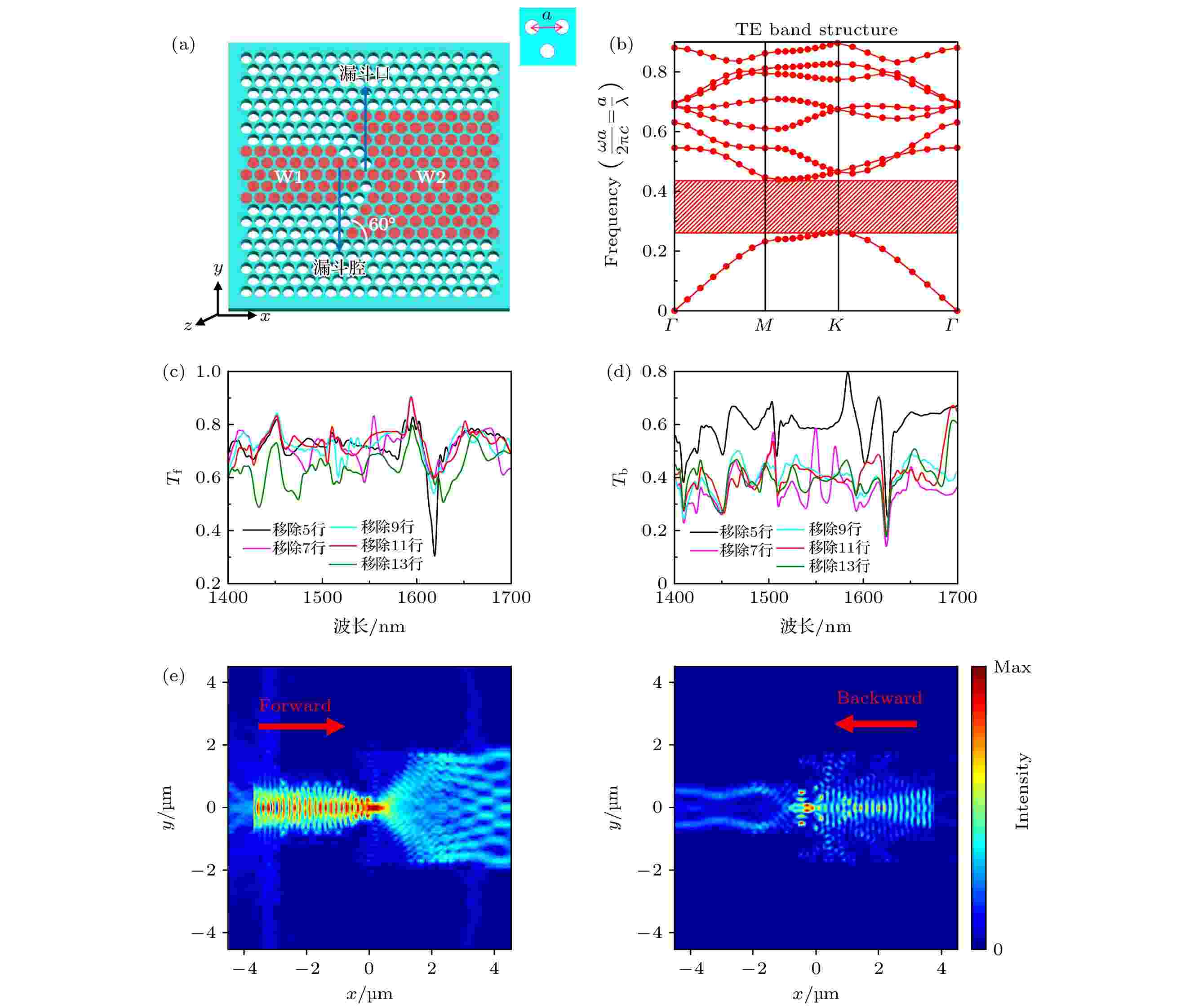
2022, 71 (3): 038501.
doi: 10.7498/aps.71.20211299
Abstract +
It will be a future trend to apply quantum photonic technology to communication technology and information processing. One of major developing directions of quantum photonic technology is the miniaturization and on-chip integration. Like the diodes in integrated electric circuitry, optical unidirectional transmitter devices (UTDs) play an important role in processing the quantum information and also represent the main components of integrated optical devices. Thus, the design of UTDs has become one of the research hotspots. With photonic bandgap and localization characteristics, as well as easy micro-nano scaled integration, the photonic crystals (PCs) are often preferred when used to develop micro-nano integrated optical devices. At present, the common methods of achieving UTD with photonic crystals include directional bandgap mismatch, asymmetrical coupling by a micro-cavity, odd-even mode conversion, total reflection of photonic crystals with grating and photonic crystal heterostructure, etc. However, these optical unidirectional transmitters gained through the above methods generally have a low forward transmission, narrow working band, complex structure, etc. In the paper a novel method of UTD is put forward based on photonic crystal and a UTD of funnel-shaped waveguide is designed. The design of the device is divided into two parts: optimal funnel waveguide design and optimal point defect design. The band structure of TE polarized photonic crystal is calculated by R-soft. A triangular lattice circular air hole photonic crystal with complete photonic band gap is used as the initial structure and line defects are introduced to form a funnel-shaped waveguide structure (FSWS). The FSWS consists of the first waveguide W1, the second waveguide W2 and a funnel cavity. The funnel cavity is shaped like a funnel and located at the coupling between W1 and W2. Owing to the unique characteristics of the waveguide, the light wave transmission will be localized in the waveguide, which is conducive to improving the forward transmission. The influence of width variation of W2 with forward and backward incident light are analyzed by the finite difference time domain (FDTD) method, and W2 is selected as a waveguide formed by removing 11 rows of air holes. The FSWS achieves the initial asymmetric transmission, while the backward transmission remains high. Further studies are conducted to introduce four types of point defects to suppress the backward transmittance. The point defects refer to moving one or two air holes. In the work the FDTD is also used to calculate four kinds of point defect backward transmittance spectra and optimize the positions of point defects. Finally, it is found that when the optimal point defect mode is type I and d = 5a, the forward transmission (Tf) and transmission contrast (C ) at 1550 nm are 0.716 and 0.929, respectively. Working bandwidth (B) can be increased up to 111 nm (1501–1612 nm). By mode analysis, it is found that the point defect introduces mode mismatch between W1 and W2, by converting the fundamental mode in W2 into high-order modes. Thus, the back-propagating light waves in W2 cannot effectively couple into W1, resulting in complete blockage of backward propagation. In addition, the structure is made of silicon based air hole photonic crystal. The 2D air-hole PC slab is mature and even compatible with conventional complementary metal oxide semiconductor (CMOS) processing. The designed UTD is easy to implement, and has the advantages of simplicity and high unidirectional transmission characteristics. Therefore, it can provide a new solution for UTDs with higher requirements for integrated optical path at present.
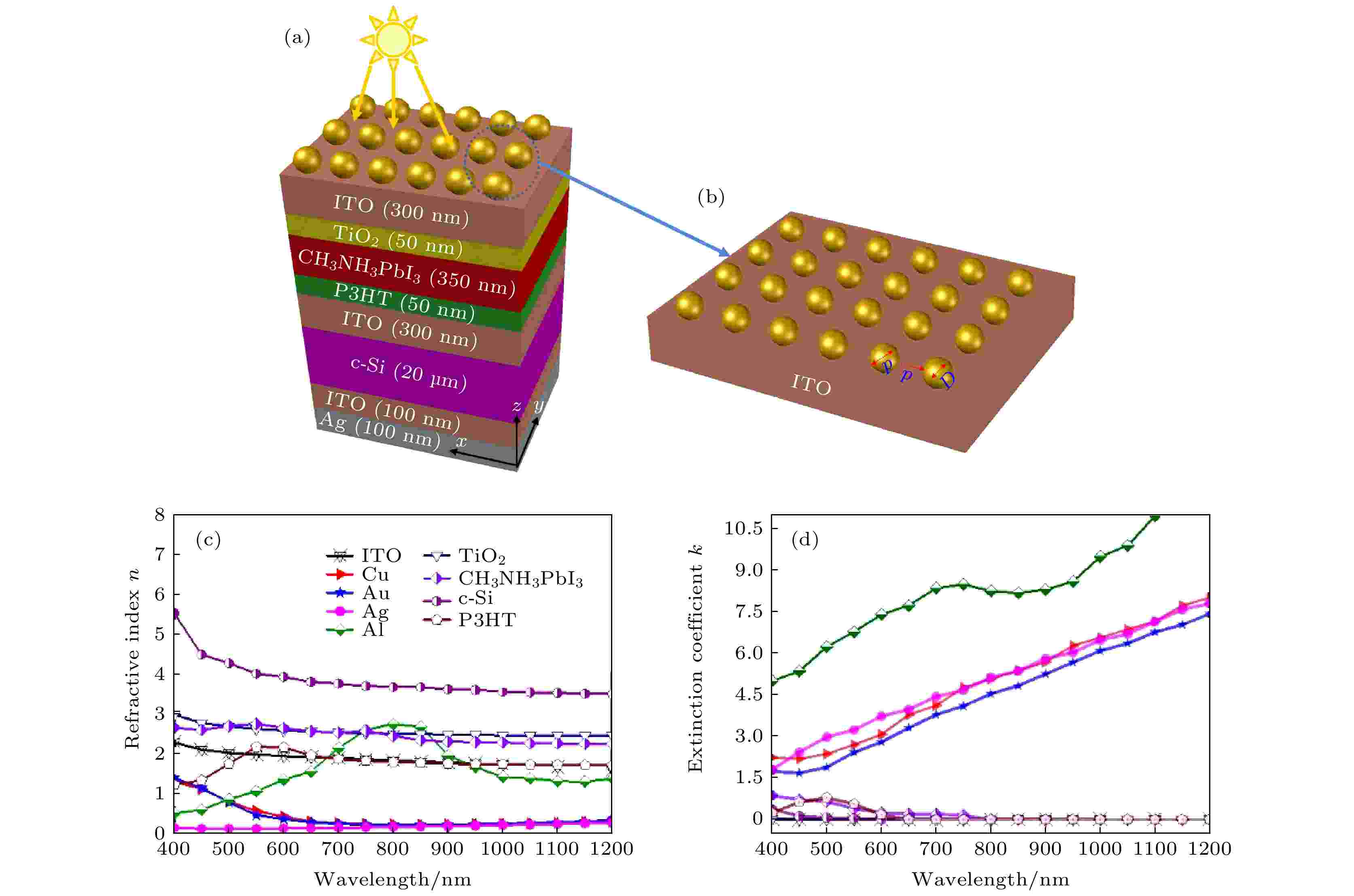
2022, 71 (3): 038801.
doi: 10.7498/aps.71.20211585
Abstract +
Perovskite/silicon tandem solar cells, by combining perovskite as a top absorber material and crystalline silicon as a bottom absorber material, can expand and enhance the utilization of solar spectrum. Therefore, such a tandem structure shows great potential to break through the Shockley-Queisser (SQ) limit of 31%-33% for single-junction (SJ) solar cells and is considered as one of the most promising approaches to achieving the higher performance in photoelectric conversion of solar cells. Reducing the optical losses from the surface and interfaces of cell device and making more photons propagate into the active layers are the key factors for achieving the goal. In this paper, the enhancement of spectral response and energy conversion efficiency of perovskite/silicon tandem solar cells depending on Au, Ag, Cu, Al nanosphere are studied by using the finite difference time domain method and rigorous coupled-wave analysis. The results show that owing to the introduction of metal nanosphere, the transmittance of photons propagating into the active material is promoted significantly. Therefore, the cell device achieves an apparent increase both in total absorbance and in quantum efficiency. The observed weighted average transmittance and energy conversion efficiency are increased from 73.16% and 23.09% to 79.15% and 24.97%, respectively, with an 8.14% improvement for the perovskite/silicon tandem solar cells coated with the optimized Al nanospheres.
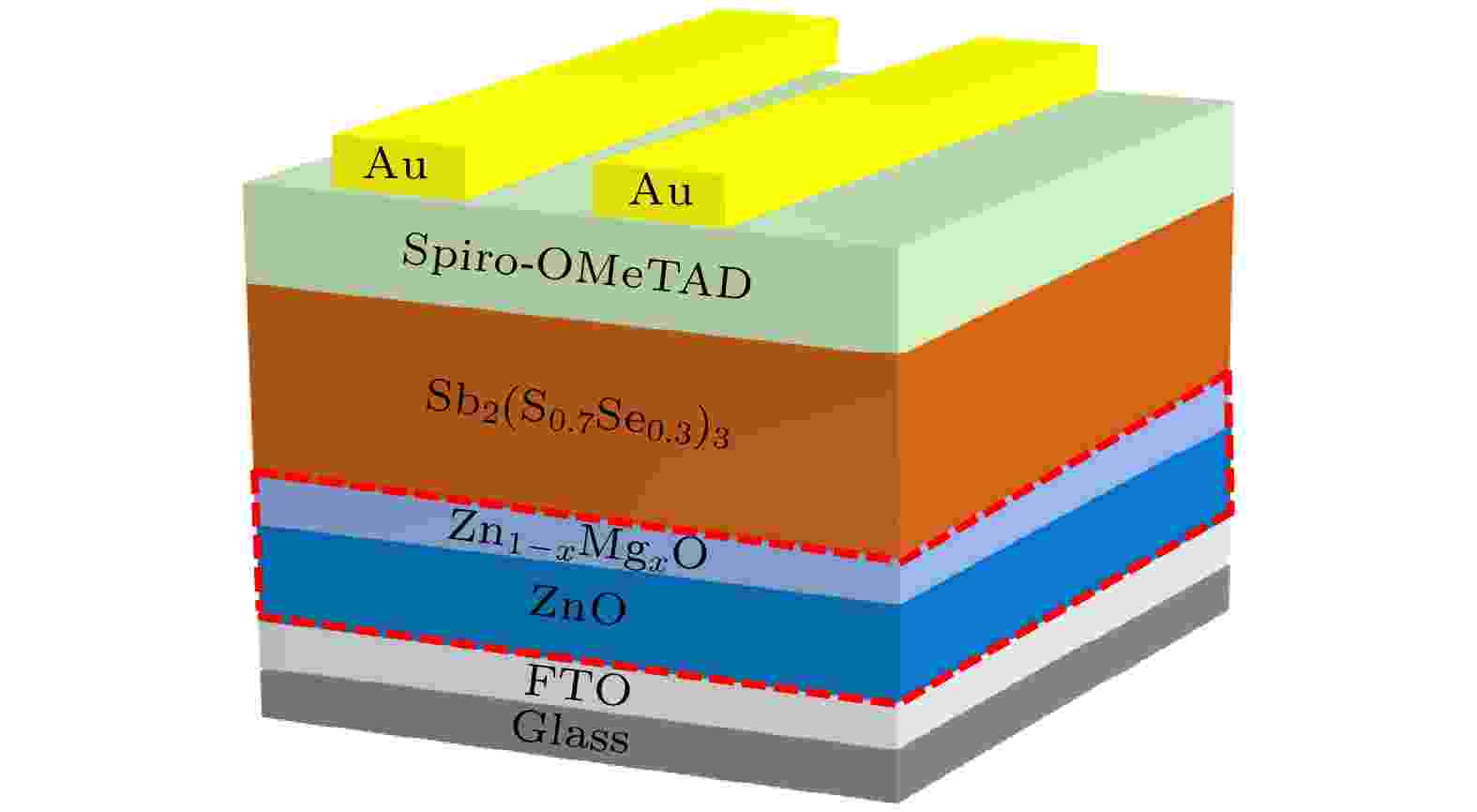
EDITOR'S SUGGESTION
2022, 71 (3): 038802.
doi: 10.7498/aps.71.20211525
Abstract +
Antimony sulfide selenide thin film solar cells have drawn great interest in the field of photovoltaic due to their advantages of simple preparation method, abundant raw materials, non-toxic and stable photoelectric properties. After the development in recent years, the photoelectric conversion efficiency of antimony sulfide selenide solar cells has exceeded 10%, which has great development potential. In this work, the carrier recombination near n/i interface in antimony sulfide selenide solar cells is studied. It is found that the characteristics of the n/i interface are affected by the interfacial electron mobility and energy band structure. The improvement of the interface electron mobility can make the electrons more effectively transferred to the electron transport layer, and realize the effective improvement of the short circuit current density and fill factor of the device. Moreover, the introduction of ZnO/Zn1–xMgxO double electron transport layer structure can further optimize the performance of antimony sulfide selenide solar cells. The change of Zn1–xMgxO energy level position can adjust the energy level distribution of the interface and light absorption layer simultaneously. When the conduction band energy level of Zn1–xMgxO is –4.2 eV and the corresponding Mg content is 20%, the effect of restraining the carrier recombination is the most obvious, and the antimony sulfide selenide solar cell also obtains the best device performance. Finally, under the ideal condition of removing the defect state, the antimony sulfide selenide solar cells with 600 nm in thickness can achieve 20.77% theoretical photoelectric conversion efficiency. The research results provide theoretical and technical support for further optimizing and developing the antimony sulfide selenide solar cells.
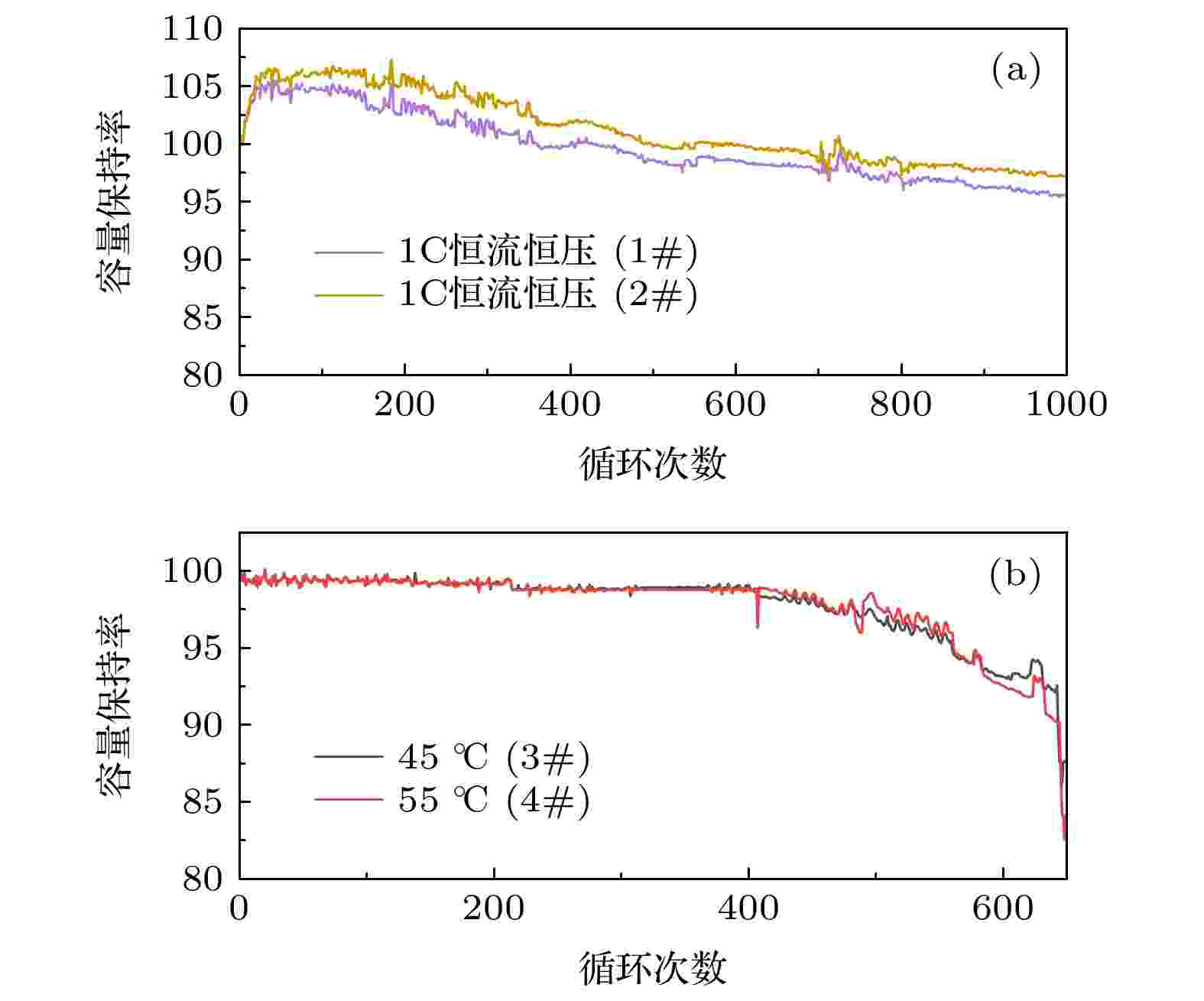
2022, 71 (3): 038803.
doi: 10.7498/aps.71.20211401
Abstract +
The current electrochemical models of lithium-ion power batteries have many problems, such as complex models, difficult modeling, low computational efficiency and poor aging evaluation effect. In this paper, a mechanism model (ADME) considering battery decay and aging is proposed. In this paper, the pseudo-two-dimensions (P2D) electrochemical model is first reduced by finite difference method to obtain a simplified P2D (SP2D). On the basis of SP2D model, a mechanism model considering battery decay and aging is proposed, which is based on the degradation and aging phenomenon caused by the side reactions between positive and negative electrodes. Secondly, the multivariate deviation compensation least square method is used to identify the model parameters. Finally, the terminal voltage output of SP2D model is compared with that of ADME model and the outputs from the two models are also analyzed through the cycle experiment on power battery aging performance, constant current and pulse condition. The results show that the ADME model is relatively simple, has high computational efficiency and estimation accuracy, and can effectively evaluate the aging decline of battery capacity, and obtain the ideal external characteristic curve of lithium ion power battery.























